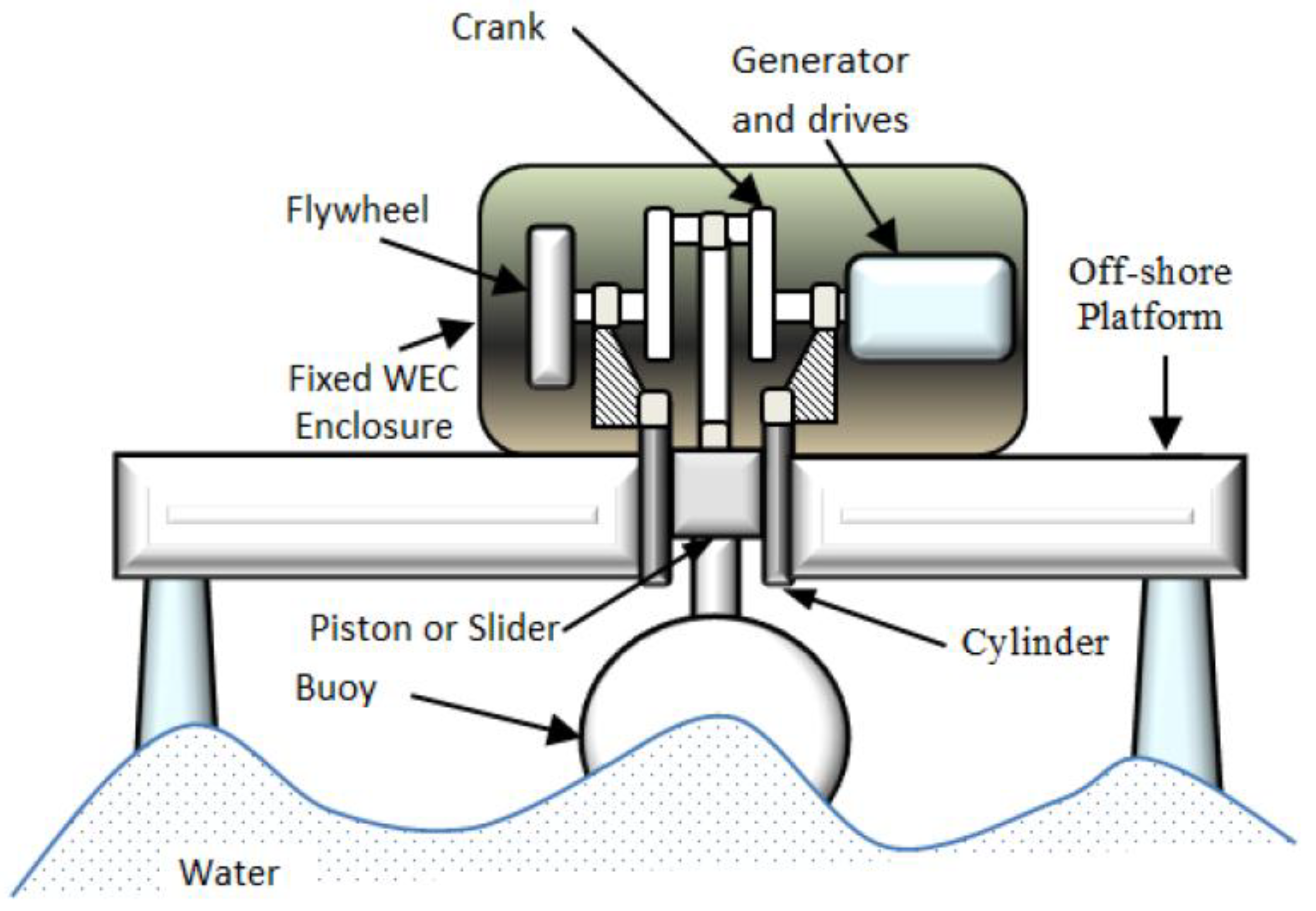Point Absorber Wave Energy Harvesters: A Review of Recent Developments
Abstract
1. Introduction
1.1. Wave Energy Resources
1.2. Wave Energy Harvesters
1.3. Challenges
- Seasonal variations: As discussed earlier, the sea states are not consistent, and they change during the year. This results in variable operating conditions and high difficulty in designing a Wave Energy Converter (WEC) which can cope and operate efficiently with these variations.
- Large wave periods: most of the types of WECs rely on resonance to achieve efficient energy capturing, and as discussed earlier, high energetic locations such as the southern Australian shores tend to have a relatively large wave period. This necessitates big devices with very large masses in order to coincide the device’s natural frequency with the ocean waves frequency and achieve resonance with the incoming waves, which results in design, manufacturing, transport, implementation, mooring, and maintenance difficulties due to the massive volumes and masses.
- Theoretical difficulties: Wave energy harvesting is very multidisciplinary containing boundary element methods of hydrodynamics [8,9,13,16,17,18,19,20,21,22,23,24,25,26,27,28], finite element methods of fluid mechanics [29,30,31,32,33], mechanical to electrical energy transfer [34], power electronics [35,36], and control theories [37,38,39,40,41]. Hydrodynamics for example are theoretically intensive, containing complicated diffraction and radiation wave theories [2] and sometimes non-linear high order wave theories [32,42,43]. This results in considerably intense modelling.
- PTO mechanisms: There are plenty of PTO mechanisms in wave energy harvesters, the main ones being linear generators [27,35,36,44], power hydraulics [45], turbines [46], linear to rotary motion transmission mechanisms [7,37,47], etc. The seasonal variance presented earlier presents a real challenge for the PTOs, as they are usually designed to operate under consistent conditions. Conventional PTOs are also designed to operate under high velocities and low forces (except for linear generators, which are the opposite), in ocean waves conditions, the velocities are low, and the forces are high, rendering the PTOs’ efficient operation tricky. Finally, there is the issue with offshore management, as these devices will be placed offshore (sometimes 40–50 kms from the landline) and maybe submerged underwater, this renders maintenance extremely difficult, and causes contamination issues for the surrounding ecological environment.
- Survivability: Harsh sea conditions, and especially under storms or unconventional sea states, where extremely high waves of large heights and forces are being excited on the WEC raise a lot of structural and survivability questions. Only a handful of WECs were tested at a large scale in the sea like the PowerBuoy in Figure 2 below.
- Finally, the transition from design to testing to commercial manufacturing has proved to be extremely difficult for wave energy harvesters, and this is caused by multiple reasons including: No WEC has standout as the definitive answer to harvesting energy from waves, especially with a large number of different designs. Scaled testing of the WECs in real seas has proved to be extremely difficult and expensive, hence resulting from the financial difficulties of commercialisations. Ruehl and Bull [48] suggested a design stage roadmap for WECs to transit from early design stages to full commercialisation. The iterations, developments, and optimization needed to reach commercialisation were detailed in the publication.
1.4. Point Absorbers Focus
2. One-Body Point Absorber
2.1. Modelling
2.1.1. Dynamics
2.1.2. Hydrodynamics
2.2. Theoretical Development
2.3. Experimental Development
2.3.1. Wave Tank Experiments
Simulation and Experimental Validation
Experimental Investigation
2.3.2. Sea Testing
3. Two-Body Point Absorber
3.1. Modelling
3.1.1. Dynamics
3.1.2. Hydrodynamics
3.2. Theoretical Development
3.3. Experimental Development
3.3.1. Wave Tank Experiments
Simulation and Experimental Validation
Experimental Investigation
3.3.2. Sea Testing
4. Power Take-Off
4.1. Linear Generators
4.2. Linear to Rotary Mechanisms
5. Mooring
6. Our Contributions
- How can one optimize the shape of the submerged oscillating body in two-body point absorbers to have a good balance between the hydrodynamic added mass and viscous damping?
- Are the hydrodynamics affected by the PTO and control forces? If so, how can one correlate the linear and non-linear hydrodynamic parameters to the PTO forces?
- Can one increase the efficiency, rigidity, and stability of linear to rotational power take offs by using a harmonic mechanism which is compatible with ocean waves?
7. Conclusions
Author Contributions
Funding
Acknowledgments
Conflicts of Interest
References
- Drew, B.; Plummer, A.R.; Sahinkaya, M.N. A review of wave energy converter technology. Proc. Inst. Mech. Eng. Part A J. Power Energy 2016, 223, 887–902. [Google Scholar] [CrossRef]
- Falcão, A.F.d.O. Wave energy utilization: A review of the technologies. Renew. Sustain. Energy Rev. 2010, 14, 899–918. [Google Scholar] [CrossRef]
- Morim, J.; Cartwright, N.; Etemad-Shahidi, A.; Strauss, D.; Hemer, M. A review of wave energy estimates for nearshore shelf waters off Australia. Int. J. Mar. Energy 2014, 7, 57–70. [Google Scholar] [CrossRef]
- Rhinefrank, K.; Schacher, A.; Prudell, J.; Hammagren, E.; von Jouanne, A.; Brekken, T. Scaled Development of a Novel Wave Energy Converter through Wave Tank to Utility-Scale Laboratory Testing. In Proceedings of the 2015 IEEE Power & Energy Society General Meeting, Denver, CO, USA, 26–30 July 2015. [Google Scholar]
- Beatty, S.J.; Hall, M.; Buckham, B.J.; Wild, P.; Bocking, B. Experimental and numerical comparisons of self-reacting point absorber wave energy converters in regular waves. Ocean Eng. 2015, 104, 370–386. [Google Scholar] [CrossRef]
- Lejerskog, E.; Boström, C.; Hai, L.; Waters, R.; Leijon, M. Experimental results on power absorption from a wave energy converter at the Lysekil wave energy research site. Renew. Energy 2015, 77, 9–14. [Google Scholar] [CrossRef]
- Liang, C.; Ai, J.; Zuo, L. Design, fabrication, simulation and testing of an ocean wave energy converter with mechanical motion rectifier. Ocean Eng. 2017, 136, 190–200. [Google Scholar] [CrossRef]
- Falnes, J. Ocean Waves and Oscillating Systems: Linear Interactions Including Wave-Energy Extraction; Cambridge University Press: Cambridge, UK, 2002. [Google Scholar]
- Evans, D.V.; de O. Falcã, A.F.; Theoretical, I.U.O.; Mechanics, A. Hydrodynamics of Ocean Wave-energy Utilization; U.S. Government Printing Office: Washington, DC, USA, 1986.
- Atlas of Wave Energy Resource in Europe. Available online: https://cordis.europa.eu/project/rcn/17972/factsheet/en (accessed on 20 July 2018).
- Illesinghe, S.J.; Manasseh, R.; Dargaville, R.; Ooi, A. Idealized design parameters of Wave Energy Converters in a range of ocean wave climates. Int. J. Mar. Energy 2017, 19, 55–69. [Google Scholar] [CrossRef]
- Bozzi, S.; Miquel, A.; Antonini, A.; Passoni, G.; Archetti, R. Modeling of a Point Absorber for Energy Conversion in Italian Seas. Energies 2013, 6, 3033–3051. [Google Scholar] [CrossRef]
- Yavuz, H.; McCabe, A.; Aggidis, G.; Widden, M.B. Calculation of the performance of resonant wave energy converters in real seas. Proc. Inst. Mech. Eng. Part M J. Eng. Marit. Environ. 2006, 220, 117–128. [Google Scholar] [CrossRef]
- Barstow, S.; Mørk, G.; Mollison, D.; Cruz, J. The Wave Energy Resource. In Ocean Wave Energy: Current Status and Future Prespectives; Cruz, J., Ed.; Springer: Berlin/Heidelberg, Germany, 2008; pp. 93–132. [Google Scholar]
- Li, Y.; Yu, Y.-H. A synthesis of numerical methods for modeling wave energy converter-point absorbers. Renew. Sustain. Energy Rev. 2012, 16, 4352–4364. [Google Scholar] [CrossRef]
- Zhao, X.-L.; Ning, D.-Z.; Göteman, M.; Kang, H.-G. Effect of the PTO damping force on the wave pressures on a 2-D wave energy converter. J. Hydrodyn. Ser. B 2017, 29, 863–870. [Google Scholar] [CrossRef]
- Piscopo, V.; Benassai, G.; Cozzolino, L.; Della Morte, R.; Scamardella, A. A new optimization procedure of heaving point absorber hydrodynamic performances. Ocean Eng. 2016, 116, 242–259. [Google Scholar] [CrossRef]
- Zheng, Y.H.; Shen, Y.M.; You, Y.G.; Wu, B.J.; Rong, L. Hydrodynamic properties of two vertical truncated cylinders in waves. Ocean Eng. 2005, 32, 241–271. [Google Scholar] [CrossRef]
- Alves, M.; Sarmento, A. Hydrodynamic Optimization of the Active surface of a Heaving Point Absorber WEC. In Proceedings of the EWTEC, Uppsala, Sweden, 7–10 September 2009. [Google Scholar]
- Eriksson, M.; Isberg, J.; Leijon, M. Hydrodynamic modelling of a direct drive wave energy converter. Int. J. Eng. Sci. 2005, 43, 1377–1387. [Google Scholar] [CrossRef]
- Engstrom, J. Hydrodynamic Modeling for a Point Absorber Wave Energy Converter. Ph.D. Thesis, Uppsala Universitet, Uppsala, Sweden, 2011. [Google Scholar]
- Shi, H.D.; Huang, S.T. Hydrodynamic Analysis of Multi-freedom Floater Wave Energy Converter. In Proceedings of the OCEANS 2016, Shanghai, China, 10–13 April 2016. [Google Scholar]
- Tampier, G.; Grueter, L. Hydrodynamic analysis of a heaving wave energy converter. Int. J. Mar. Energy 2017, 19, 304–318. [Google Scholar] [CrossRef]
- Rahman, M.; Bhatta, D.D. Evaluation of added mass and damping coefficient of an oscillating circular cylinder. Appl. Math. Model. 1993, 17, 70–79. [Google Scholar] [CrossRef]
- Falnes, J. On non-causal impulse response functions related to propagating water waves. Appl. Ocean Res. 1995, 17, 379–389. [Google Scholar] [CrossRef]
- Penalba, M.; Mérigaud, A.; Gilloteaux, J.-C.; Ringwood, J.V. Influence of nonlinear Froude–Krylov forces on the performance of two wave energy points absorbers. J. Ocean Eng. Mar. Energy 2017, 3, 209–220. [Google Scholar] [CrossRef]
- Engström, J.; Kurupath, V.; Isberg, J.; Leijon, M. A resonant two body system for a point absorbing wave energy converter with direct-driven linear generator. J. Appl. Phys. 2011, 110. [Google Scholar] [CrossRef]
- Koh, H.-J.; Ruy, W.-S.; Cho, I.-H.; Kweon, H.-M. Multi-objective optimum design of a buoy for the resonant-type wave energy converter. J. Mar. Sci. Technol. 2014, 20, 53–63. [Google Scholar] [CrossRef]
- Chen, L.F.; Zang, J.; Hillis, A.J.; Morgan, G.C.J.; Plummer, A.R. Numerical investigation of wave–structure interaction using OpenFOAM. Ocean Eng. 2014, 88, 91–109. [Google Scholar] [CrossRef]
- Connell, K.O.; Cashman, A. Development of a numerical wave tank with reduced discretization error. In Proceedings of the 2016 International Conference on Electrical, Electronics, and Optimization Techniques (ICEEOT), Chennai, India, 3–5 March 2016; pp. 3008–3012. [Google Scholar]
- Bhinder, M.; Babarit, A.; Gentaz, L.; Ferrant, P. Assessment of Viscous Damping via 3D-CFD Modelling of a Floating Wave Energy Device. In Proceedings of the 9th European Wave and Tidal Energy Conference, Southampton, UK, 5–9 September 2011. [Google Scholar]
- Giorgi, G.; Ringwood, J.V. Nonlinear Froude-Krylov and viscous drag representations for wave energy converters in the computation/fidelity continuum. Ocean Eng. 2017, 141, 164–175. [Google Scholar] [CrossRef]
- Giuseppe Giorgi, J.V.R. Consistency of Viscous Drag Identification Tests for Wave Energy Applications. In Proceedings of the 12th European Wave and Tidal Energy Conference (EWTEC), Cork, Ireland, 27 August–1 September 2017. [Google Scholar]
- Wang, X. Analysis of Electromagnetic Vibration Energy Harvesters With Different Interface Circuits. In Frequency Analysis of Vibration Energy Harvesting Systems; Elsevier Inc.: Amesterdam, The Netherlands, 2016; pp. 69–106. [Google Scholar]
- Polinder, H.; Mecrow, B.C.; Jack, A.G.; Dickinson, P.G.; Mueller, M.A. Conventional and TFPM Linear Generators for Direct-Drive Wave Energy Conversion. IEEE Trans. Energy Convers. 2005, 20, 260–267. [Google Scholar] [CrossRef]
- Polinder, H.; Damen, M.E.C.; Gardner, F. Design, modelling and test results of the AWS PM linear generator. Eur. Trans. Electr. Power 2005, 15, 245–256. [Google Scholar] [CrossRef]
- Sang, Y.R.; Karayaka, H.B.; Yan, Y.J.; Zhang, J.Z. Resonance Control Strategy for A Slider Crank WEC Power Take-off System. In Proceedings of the 2014 OCEANS, St. John’s, NL, Canada, 14–19 September 2014. [Google Scholar]
- Babarit, A.; Clément, A.H. Optimal latching control of a wave energy device in regular and irregular waves. Appl. Ocean Res. 2006, 28, 77–91. [Google Scholar] [CrossRef]
- Richter, M.; Magana, M.E.; Sawodny, O.; Brekken, T.K.A. Nonlinear Model Predictive Control of a Point Absorber Wave Energy Converter. IEEE Trans. Sustain. Energy 2013, 4, 118–126. [Google Scholar] [CrossRef]
- Giorgi, G.; Ringwood, J.V. Implementation of latching control in a numerical wave tank with regular waves. J. Ocean Eng. Mar. Energy 2016, 2, 211–226. [Google Scholar] [CrossRef]
- Park, J.S.; Gu, B.-G.; Kim, J.R.; Cho, I.H.; Jeong, I.; Lee, J. Active Phase Control for Maximum Power Point Tracking of a Linear Wave Generator. IEEE Trans. Power Electr. 2017, 32, 7651–7662. [Google Scholar] [CrossRef]
- Zurkinden, A.S.; Ferri, F.; Beatty, S.; Kofoed, J.P.; Kramer, M.M. Non-linear numerical modeling and experimental testing of a point absorber wave energy converter. Ocean Eng. 2014, 78, 11–21. [Google Scholar] [CrossRef]
- Guo, B.; Patton, R.; Jin, S.; Gilbert, J.; Parsons, D. Non-linear Modelling and Verification of a Heaving Point Absorber for Wave Energy Conversion. IEEE Trans. Sustain. Energy 2017, 9, 453–461. [Google Scholar] [CrossRef]
- Ulvgård, L.; Sjökvist, L.; Göteman, M.; Leijon, M. Line Force and Damping at Full and Partial Stator Overlap in a Linear Generator for Wave Power. J. Mar. Sci. Eng. 2016, 4, 81. [Google Scholar] [CrossRef]
- Ruehl, K.; Brekken, T.K.A.; Bosma, B.; Paasch, R. Large-scale ocean wave energy plant modeling. In Proceedings of the 2010 IEEE Conference on Innovative Technologies for an Efficient and Reliable Electricity Supply, Waltham, MA, USA, 27–29 September 2010; pp. 379–386. [Google Scholar]
- Kim, B.-H.; Wata, J.; Zullah, M.A.; Ahmed, M.R.; Lee, Y.-H. Numerical and experimental studies on the PTO system of a novel floating wave energy converter. Renew. Energy 2015, 79, 111–121. [Google Scholar] [CrossRef]
- Sang, Y.; Karayaka, H.; Yan, Y.; Zhang, J.Z.; Muljadi, E.; Yu, Y.-H. Energy extraction from a slider-crank wave energy converter under irregular wave conditions. In Proceedings of the OCEANS 2015—MTS, Washington, DC, USA, 19–22 October 2015; pp. 1–7. [Google Scholar]
- Ruehl, K.; Bull, D. Wave Energy Development Roadmap: Design to Commercialization. In Proceedings of the 2012 OCEANS, Hampton Roads, VA, USA, 14–19 October 2012. [Google Scholar]
- Yu, Y.-H.; Li, Y. Reynolds-Averaged Navier–Stokes simulation of the heave performance of a two-body floating-point absorber wave energy system. Comput. Fluids Comput. Fluids 2013, 73, 104–114. [Google Scholar] [CrossRef]
- Leavitt, C. Mechanism for Utilizing Wave-Power. U.S. Patent US321229A, 30 June 1885. [Google Scholar]
- Cummins, W.E. The impulse response function and ship motions. Symp. Ship Theory 1962, 9, 101–109. [Google Scholar]
- Falnes, J. Wave-energy conversion through relative motion between two single-mode oscillating bodies. J. Offshore Mech. Arct. 1999, 121, 32–38. [Google Scholar] [CrossRef]
- Hirohisa, T. Sea trial of a heaving buoy wave power absorber. In Proceedings of the 2nd International Symposium on Wave Energy Utilization, Trondheim, Norway, 22–24 June 1982; pp. 323–344. [Google Scholar]
- Budal, K.; Falnes, J.; Iversen, L.C.; Lillebekken, P.M.; Oltedal, G.; Hals, T.; Onshus, T.; Høy, A.S. The Norwegian wave-power buoy project. In Proceedings of the 2nd International Symposium on Wave Energy Utilization, Trondheim, Norway, 22–24 June 1982; pp. 323–344. [Google Scholar]
- Babarit, A.; Hals, J.; Muliawan, M.J.; Kurniawan, A.; Moan, T.; Krokstad, J. Numerical benchmarking study of a selection of wave energy converters. Renew. Energy 2012, 41, 44–63. [Google Scholar] [CrossRef]
- Chen, W.; Dolguntseva, I.; Savin, A.; Zhang, Y.; Li, W.; Svensson, O.; Leijon, M. Numerical modelling of a point-absorbing wave energy converter in irregular and extreme waves. Appl. Ocean Res. 2017, 63, 90–105. [Google Scholar] [CrossRef]
- Wang, L.; Isberg, J.; Tedeschi, E. Review of control strategies for wave energy conversion systems and their validation: the wave-to-wire approach. Renew. Sustain. Energy Rev. 2018, 81, 366–379. [Google Scholar] [CrossRef]
- Ringwood, J.; Bacelli, G.; Fusco, F. Energy-Maximizing Control of Wave-Energy Converters: The Development of Control System Technology to Optimize Their Operation. IEEE Control Syst. 2014, 34, 30–55. [Google Scholar]
- Genest, R.; Bonnefoy, F.; Clément, A.H.; Babarit, A. Effect of non-ideal power take-off on the energy absorption of a reactively controlled one degree of freedom wave energy converter. Appl. Ocean Res. 2014, 48, 236–243. [Google Scholar] [CrossRef]
- Arena, F.; Laface, V.; Malara, G.; Romolo, A.; Viviano, A.; Fiamma, V.; Sannino, G.; Carillo, A. Wave climate analysis for the design of wave energy harvesters in the Mediterranean Sea. Renew. Energy 2015, 77, 125–141. [Google Scholar] [CrossRef]
- Santhosh, N.; Baskaran, V.; Amarkarthik, A. A review on front end conversion in ocean wave energy converters. Front. Energy 2015, 9, 297–310. [Google Scholar] [CrossRef]
- Cornett, A. A Global Wave Energy Resource Assessment. In Proceedings of the Eighteenth International Offshore and Polar Engineering Conference, Vancouver, BC, Canada, 6–11 July 2008. [Google Scholar]
- Jin, S.; Patton, R.J.; Guo, B. Viscosity effect on a point absorber wave energy converter hydrodynamics validated by simulation and experiment. Renew. Energy 2018, 129, 500–512. [Google Scholar] [CrossRef]
- Guo, Q.; Xu, Z. Simulation of deep-water waves based on JONSWAP spectrum and realization by MATLAB. In Proceedings of the 2011 19th International Conference on Geoinformatics, Shanghai, China, 24–26 June 2011; pp. 1–4. [Google Scholar]
- Kara, F. Time domain prediction of power absorption from ocean waves with latching control. Renew. Energy 2010, 35, 423–434. [Google Scholar] [CrossRef]
- Pastor, J.; Liu, Y. Frequency and time domain modeling and power output for a heaving point absorber wave energy converter. Int. J. Energy Environ. Eng. 2014, 5. [Google Scholar] [CrossRef]
- McCabe, A.P.; Aggidis, G.A. Optimum mean power output of a point-absorber wave energy converter in irregular waves. Proc. Inst. Mech. Eng. Part A J. Power Energy 2009, 223, 773–781. [Google Scholar] [CrossRef]
- Sergiienko, N.Y.; Cazzolato, B.S.; Ding, B.; Hardy, P.; Arjomandi, M. Performance comparison of the floating and fully submerged quasi-point absorber wave energy converters. Renew. Energy 2017, 108, 425–437. [Google Scholar] [CrossRef]
- Koh, H.-J.; Cho, I.-H. Heave motion response of a circular cylinder with the dual damping plates. Ocean Eng. 2016, 125, 95–102. [Google Scholar] [CrossRef]
- Wen, Y.; Wang, W.; Liu, H.; Mao, L.; Mi, H.; Wang, W.; Zhang, G. A Shape Optimization Method of a Specified Point Absorber Wave Energy Converter for the South China Sea. Energies 2018, 11, 2645. [Google Scholar] [CrossRef]
- Zhang, X.; Yang, J.; Xiao, L. Numerical Study of an Oscillating Wave Energy Converter with Nonlinear Snap-Through Power-Take-Off Systems in Regular Waves. In Proceedings of the 24th International Ocean and Polar Engineering Conference, Busan, Korea, 15–20 June 2014. [Google Scholar]
- Yin, X.; Zhao, X.; Zhang, W. A novel hydro-kite like energy converter for harnessing both ocean wave and current energy. Energy 2018, 158, 1204–1212. [Google Scholar] [CrossRef]
- Abdelkhalik, O.; Darani, S. Optimization of nonlinear wave energy converters. Ocean Eng. 2018, 162, 187–195. [Google Scholar] [CrossRef]
- Agamloh, E.B.; Wallace, A.K.; von Jouanne, A. Application of fluid–structure interaction simulation of an ocean wave energy extraction device. Renew. Energy 2008, 33, 748–757. [Google Scholar] [CrossRef]
- Göteman, M. Wave energy parks with point-absorbers of different dimensions. J. Fluids Struct. 2017, 74, 142–157. [Google Scholar] [CrossRef]
- Babarit, A.; Borgarino, B.; Ferrant, P.; Clement, A. Assessment of the influence of the distance between two wave energy converters on energy production. IET Renew. Power Gener. 2010, 4, 592–601. [Google Scholar] [CrossRef]
- Vantorre, M.; Banasiak, R.; Verhoeven, R. Modelling of hydraulic performance and wave energy extraction by a point absorber in heave. Appl. Ocean Res. 2004, 26, 61–72. [Google Scholar] [CrossRef]
- Lok, K.S.; Stallard, T.J.; Stansby, P.K.; Jenkins, N. Optimisation of a clutch-rectified power take off system for a heaving wave energy device in irregular waves with experimental comparison. Int. J. Mar. Energy 2014, 8, 1–16. [Google Scholar] [CrossRef]
- Binh, P.C.; Dung, D.T.; Koo, W.; Ahn, K.K.; Tri, N.M.; Kim, S.-J. Analysis, design and experiment investigation of a novel wave energy converter. IET Gener. Transm. Distrib. 2016, 10, 460–469. [Google Scholar] [CrossRef]
- Guo, B.; Patton, R.J.; Jin, S.; Lan, J. Numerical and experimental studies of excitation force approximation for wave energy conversion. Renew. Energy 2018, 125, 877–889. [Google Scholar] [CrossRef]
- Alamian, R.; Shafaghat, R.; Bayani, R.; Amouei, A.H. An experimental evaluation of the effects of sea depth, wave energy converter’s draft and position of centre of gravity on the performance of a point absorber wave energy converter. J. Mar. Eng. Technol. 2017, 16, 70–83. [Google Scholar] [CrossRef]
- Göteman, M.; Engström, J.; Eriksson, M.; Leijon, M.; Hann, M.; Ransley, E.; Greaves, D. Wave Loads on a Point-Absorbing Wave Energy Device in Extreme Waves. J. Ocean Wind Energy 2015, 2, 176–181. [Google Scholar] [CrossRef]
- Zang, Z.; Zhang, Q.; Qi, Y.; Fu, X. Hydrodynamic responses and efficiency analyses of a heaving-buoy wave energy converter with PTO damping in regular and irregular waves. Renew. Energy 2018, 116, 527–542. [Google Scholar] [CrossRef]
- Davis, A.F.; Thomson, J.; Mundon, T.R.; Fabien, B.C. Modeling and Analysis of a Multi Degree of Freedom Point Absorber Wave Energy Converter. In Proceedings of the 33rd International Conference on Ocean, Offshore and Arctic Engineering, San Francisco, CA, USA, 8–13 June 2014. [Google Scholar]
- Rhinefrank, K.; Schacher, A.; Prudell, J.; Hammagren, E.; Zhang, Z.; Stillinger, C.; Brekken, T.; von Jouanne, A.; Yim, S. Development of a Novel 1:7 Scale Wave Energy Converter. In Proceedings of the ASME 30th International Conference on Ocean, Offshore and Arctic Engineering, Rotterdam, The Netherlands, 19–24 June 2011; Volume 5. [Google Scholar]
- Liang, C.; Zuo, L. On the dynamics and design of a two-body wave energy converter. Renew. Energy 2017, 101, 265–274. [Google Scholar] [CrossRef]
- Siow, C.; Koto, J.; Abyn, H.; Khairuddin, N. Linearized Morison Drag for Improvement Semi-Submersible Heave Response Prediction by Diffraction Potential. Sci. Eng. 2014, 6, 8–16. [Google Scholar]
- Bosma, B.; Zhang, Z.; Brekken, T.K.A.; Ozkan-Haller, H.T.; McNatt, C.; Yim, S.C. Wave Energy Converter Modeling in the Frequency Domain: A Design Guide. IEEE Energy Convers. 2012, 2099–2106. [Google Scholar]
- Bosma, B.; Brekken, T.K.A.; Ozkan-Haller, H.T.; Yim, S.C. Wave Energy Converter Modeling in the Time Domain: A Design Guide. In Proceedings of the 2013 1st IEEE Conference on Technologies for Sustainability (SusTech), Portland, OR, USA, 1–2 August 2013; pp. 103–108. [Google Scholar]
- Wu, B.; Wang, X.; Diao, X.; Peng, W.; Zhang, Y. Response and conversion efficiency of two degrees of freedom wave energy device. Ocean Eng. 2014, 76, 10–20. [Google Scholar] [CrossRef]
- Amiri, A.; Panahi, R.; Radfar, S. Parametric study of two-body floating-point wave absorber. J. Mar. Sci. Appl. 2016, 15, 41–49. [Google Scholar] [CrossRef]
- Tarrant, K.; Meskell, C. Investigation on parametrically excited motions of point absorbers in regular waves. Ocean Eng. 2016, 111, 67–81. [Google Scholar] [CrossRef]
- Son, D.; Belissen, V.; Yeung, R.W. Performance validation and optimization of a dual coaxial-cylinder ocean-wave energy extractor. Renew. Energy 2016, 92, 192–201. [Google Scholar] [CrossRef]
- Al Shami, E.; Wang, X.; Zhang, R.; Zuo, L. A parameter study and optimization of two body wave energy converters. Renew. Energy 2019, 131, 1–13. [Google Scholar] [CrossRef]
- Gao, Y.; Shao, S.; Zou, H.; Tang, M.; Xu, H.; Tian, C. A fully floating system for a wave energy converter with direct-driven linear generator. Energy 2016, 95, 99–109. [Google Scholar] [CrossRef]
- Chen, Z.; Zhou, B.; Zhang, L.; Sun, L.; Zhang, X. Performance evaluation of a dual resonance wave-energy convertor in irregular waves. Appl. Ocean Res. 2018, 77, 78–88. [Google Scholar] [CrossRef]
- Kim, J.; Koh, H.J.; Cho, I.H.; Kim, M.H.; Kweon, H.M. Experimental study of wave energy extraction by a dual-buoy heaving system. Int. J. Naval Arch. Ocean Eng. 2017, 9, 25–34. [Google Scholar] [CrossRef]
- Rhinefrank, K.; Schacher, A.; Prudell, J.; Cruz, J.; Jorge, N.; Stillinger, C.; Naviaux, D.; Brekken, T.; von Jouanne, A.; Newborn, D.; et al. Numerical and experimental analysis of a novel wave energy converter. In Proceedings of the ASME 29th International Conference on Ocean, Offshore and Arctic Engineering, Shanghai, China, 6–11 June 2010; Volume 3, pp. 559–567. [Google Scholar]
- Xiao, H.; Wang, X.; John, S. A multi-degree of freedom piezoelectric vibration energy harvester with piezoelectric elements inserted between two nearby oscillators. Mech. Syst. Signal Process. 2016, 68–69, 138–154. [Google Scholar] [CrossRef]
- Viet, N.V.; Xie, X.D.; Liew, K.M.; Banthia, N.; Wang, Q. Energy harvesting from ocean waves by a floating energy harvester. Energy 2016, 112, 1219–1226. [Google Scholar] [CrossRef]
- Ahmadian, M.; Murray, R.; Ghasemi-Nejhad, M.N.; Rastegar, J. Novel two-stage piezoelectric-based ocean wave energy harvesters for moored or unmoored buoys. In Proceedings of the Active and Passive Smart Structures and Integrated Systems, San Diego, CA, USA, 9–12 March 2009. [Google Scholar]
- Crozier, R.; McKeever, P.; Mueller, M.; Spooner, E.; Bailey, H. Analysis, design and testing of a novel direct-drive wave energy converter system. IET Renew. Power Gener. 2013, 7, 565–573. [Google Scholar] [CrossRef]
- Ozkop, E.; Altas, I.H. Control, power and electrical components in wave energy conversion systems: A review of the technologies. Renew. Sustain. Energy Rev. 2017, 67, 106–115. [Google Scholar] [CrossRef]
- Rhinefrank, K.; Schacher, A.; Prudell, J.; Brekken, T.K.A.; Stillinger, C.; Yen, J.Z.; Ernst, S.G.; von Jouanne, A.; Amon, E.; Paasch, R.; et al. Comparison of Direct-Drive Power Takeoff Systems for Ocean Wave Energy Applications. IEEE J. Oceanic Eng. 2012, 37, 35–44. [Google Scholar] [CrossRef]
- Agamloh, E.B.; Wallace, A.K.; von Jouanne, A. A novel direct-drive ocean wave energy extraction concept with contact-less force transmission system. Renew. Energy 2008, 33, 520–529. [Google Scholar] [CrossRef]
- De Koker, K.L.; Degrieck, J.; De Maeyer, J.; Verbelen, F.; Verbrugghe, T.; Vantorre, M.; Vandevelde, L. Modeling of a Power Sharing Transmission in a Wave Energy Converter. In Proceedings of the 2016 IEEE 16th International Conference on Environment and Electrical Engineering (Eeeic), Florence, Italy, 7–10 June 2016. [Google Scholar]
- Boren, B.C.; Lomonaco, P.; Batten, B.A.; Paasch, R.K. Design, Development, and Testing of a Scaled Vertical Axis Pendulum Wave Energy Converter. IEEE Trans. Sustain. Energy 2017, 8, 155–163. [Google Scholar] [CrossRef]
- Takaramoto, R.; Kashiwagi, M.; Sakai, K. Wave Energy Absorption in Irregular Waves by a Floating Body Equipped with Interior Rotating Electric-Power Generator. In Proceedings of the 24 International Ocean and Polar Engineering Conference, Busan, Korea, 15–20 June 2014. [Google Scholar]
- Dai, Y.; Chen, Y.; Xie, L. A study on a novel two-body floating wave energy converter. Ocean Eng. 2017, 130, 407–416. [Google Scholar] [CrossRef]
- Hadano, K.; Lee, K.Y.; Moon, B.Y. A study on dynamic motion and wave power in multi-connected wave energy converter. Ships Offshore Struct. 2016, 11, 679–687. [Google Scholar] [CrossRef]
- Harris, R.; Johanning, L.; Wolfram, J. Mooring Systems for Wave Energy Converters: A Review of Design Issues and Choices. Proc. Inst. Mech. Eng. Part B J. Eng. Manuf. 2006, 220, 159–168. [Google Scholar]
- Fitzgerald, J.; Bergdahl, L. Including moorings in the assessment of a generic offshore wave energy converter: A frequency domain approach. Mar. Struct. 2008, 21, 23–46. [Google Scholar] [CrossRef]
- Vicente, P.C.; Falcão, A.F.O.; Justino, P.A.P. Nonlinear dynamics of a tightly moored point-absorber wave energy converter. Ocean Eng. 2013, 59, 20–36. [Google Scholar] [CrossRef]
- Bachynski, E.E.; Young, Y.L.; Yeung, R.W. Analysis and optimization of a tethered wave energy converter in irregular waves. Renew. Energy 2012, 48, 133–145. [Google Scholar] [CrossRef]
- Liu, Z.; Wang, X.; Zhang, R.; Wang, L. A Dimensionless Parameter Analysis of a Cylindrical Tube Electromagnetic Vibration Energy Harvester and Its Oscillator Nonlinearity Effect. Energies 2018, 11, 1653. [Google Scholar] [CrossRef]
- McNabb, L.; Wang, L.; McGrath, B. Intrinsically stable realization of a resonant current regulator for a single phase inverter. In Proceedings of the 2017 11th Asian Control Conference (ASCC), Gold Coast, Australia, 17–20 December 2017; pp. 2256–2261. [Google Scholar]
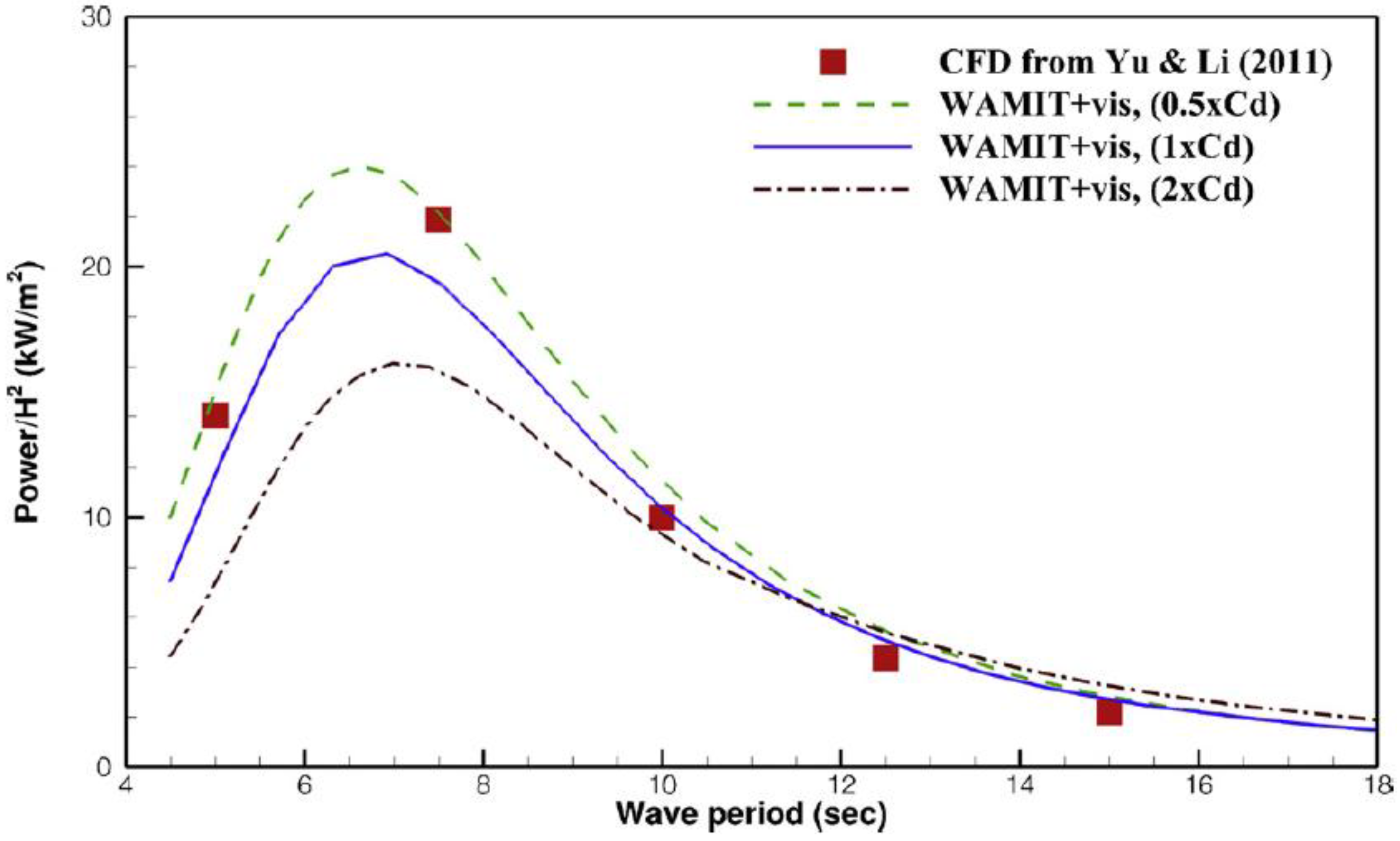
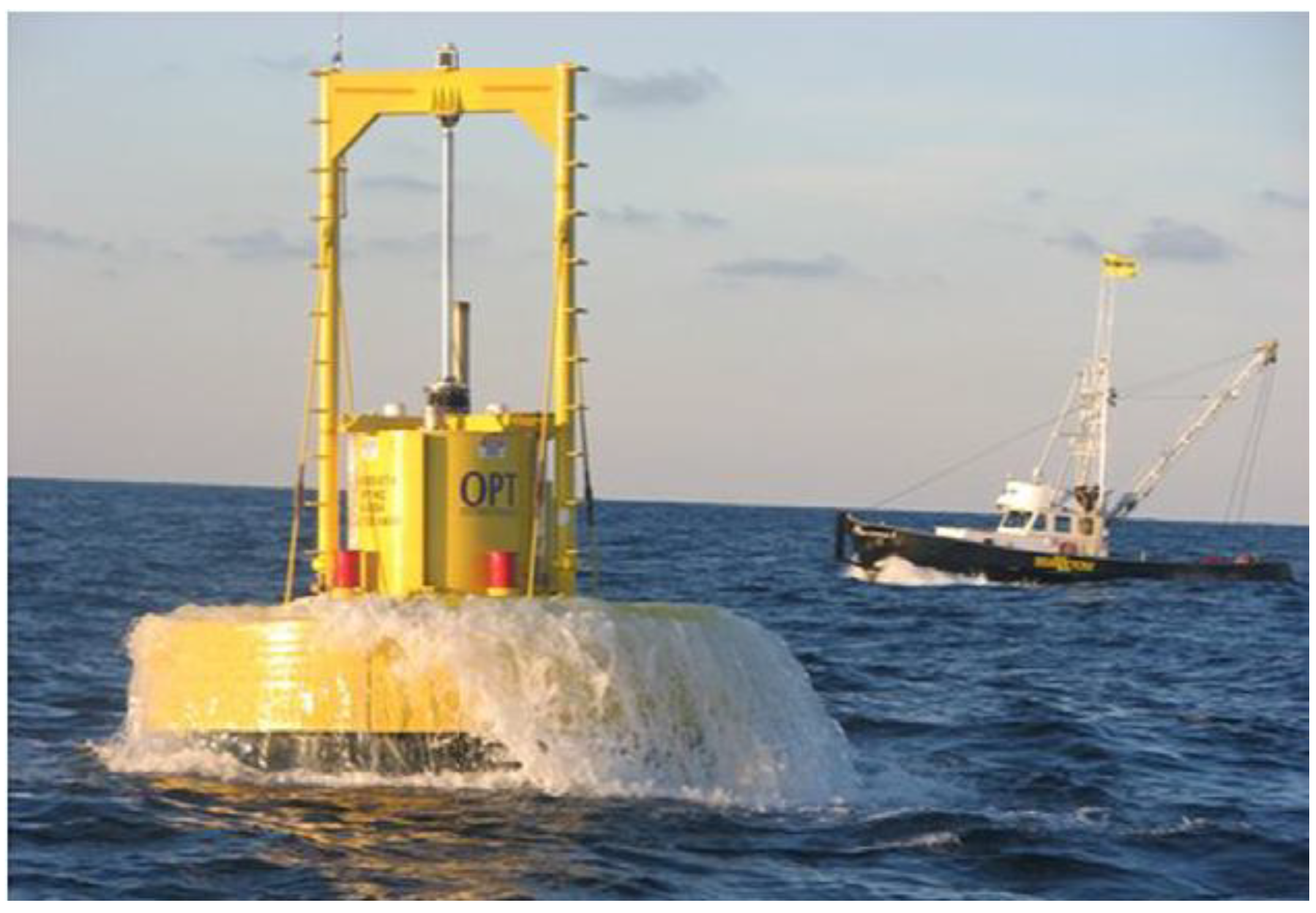
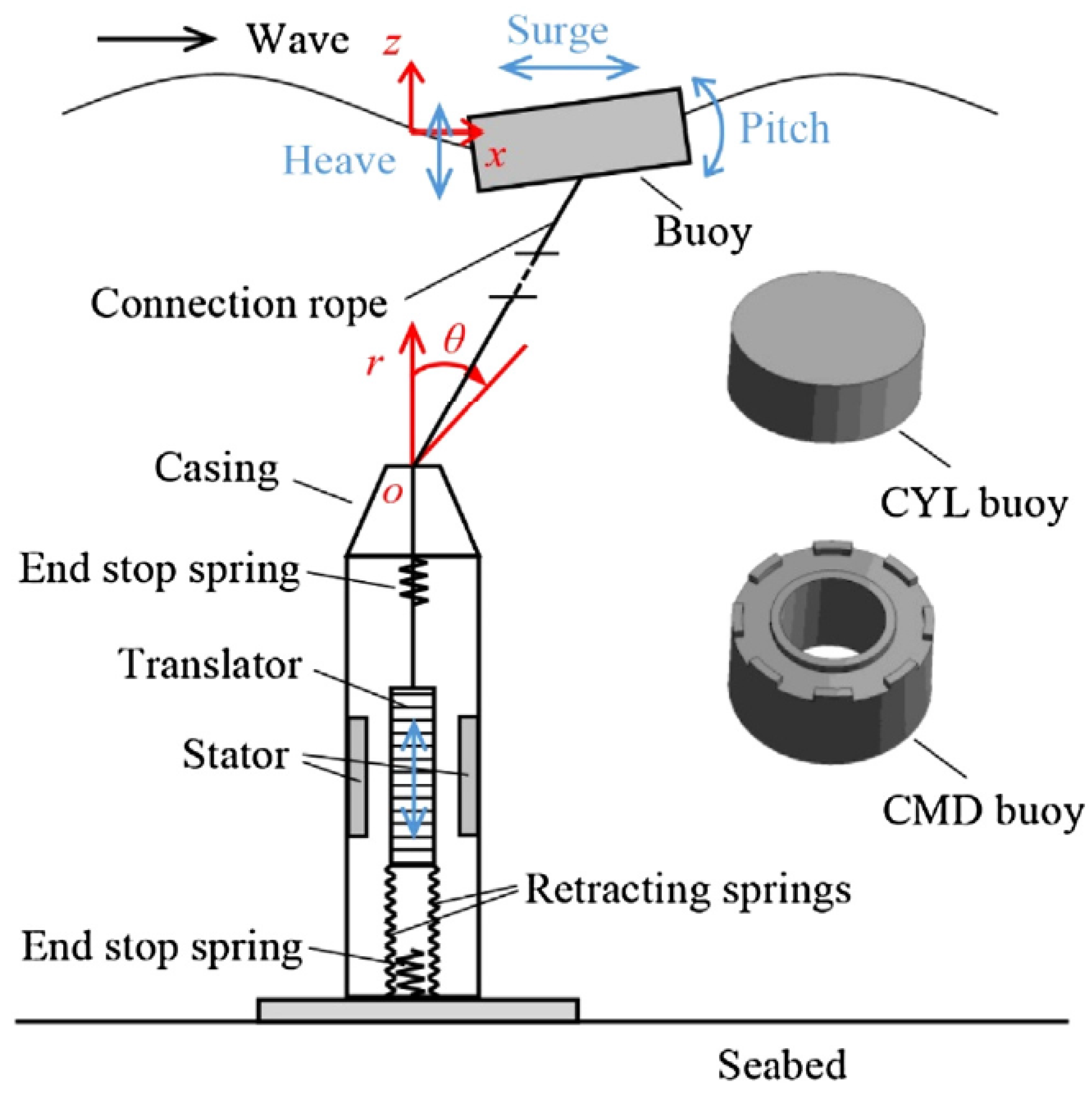
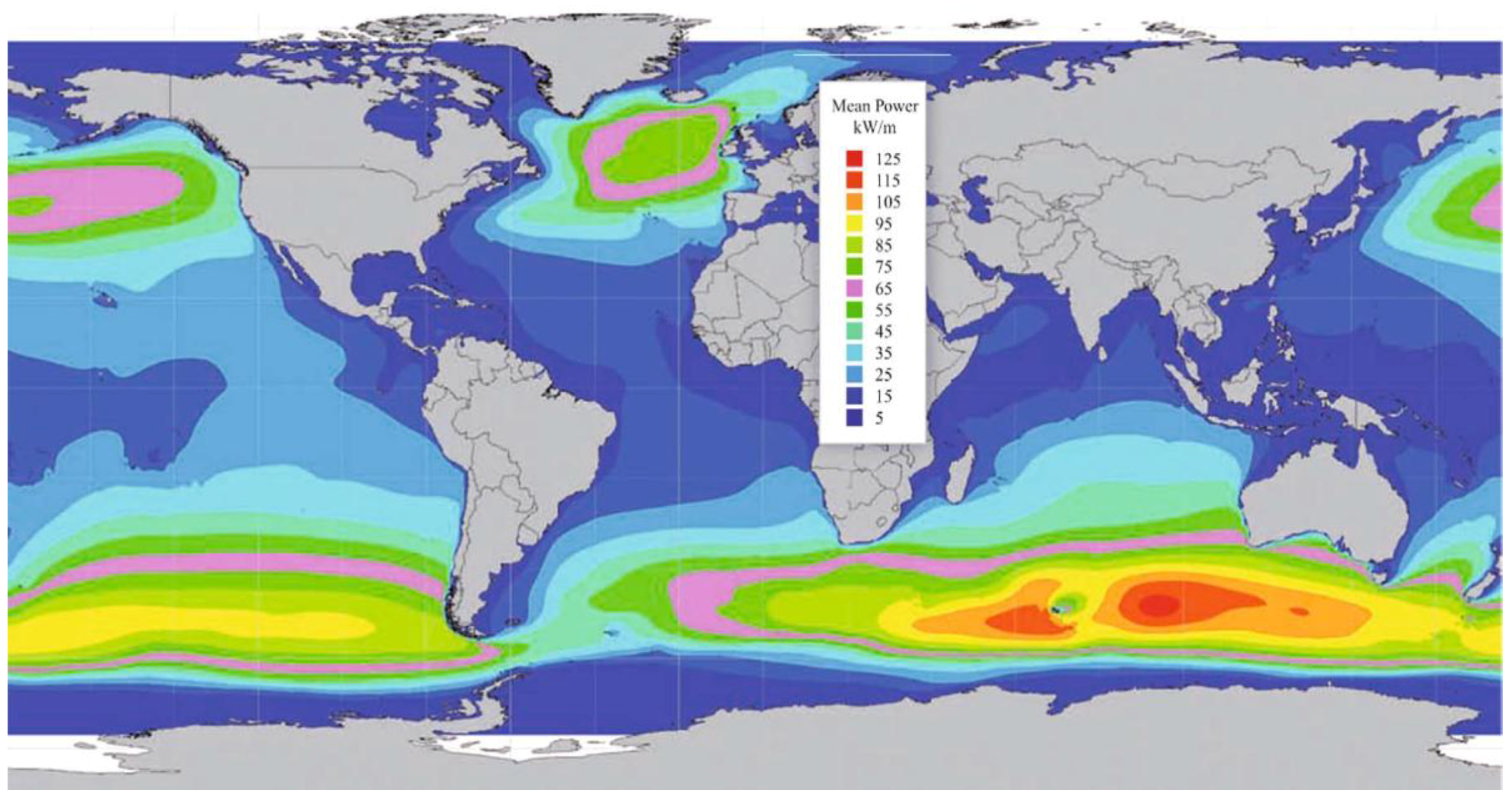
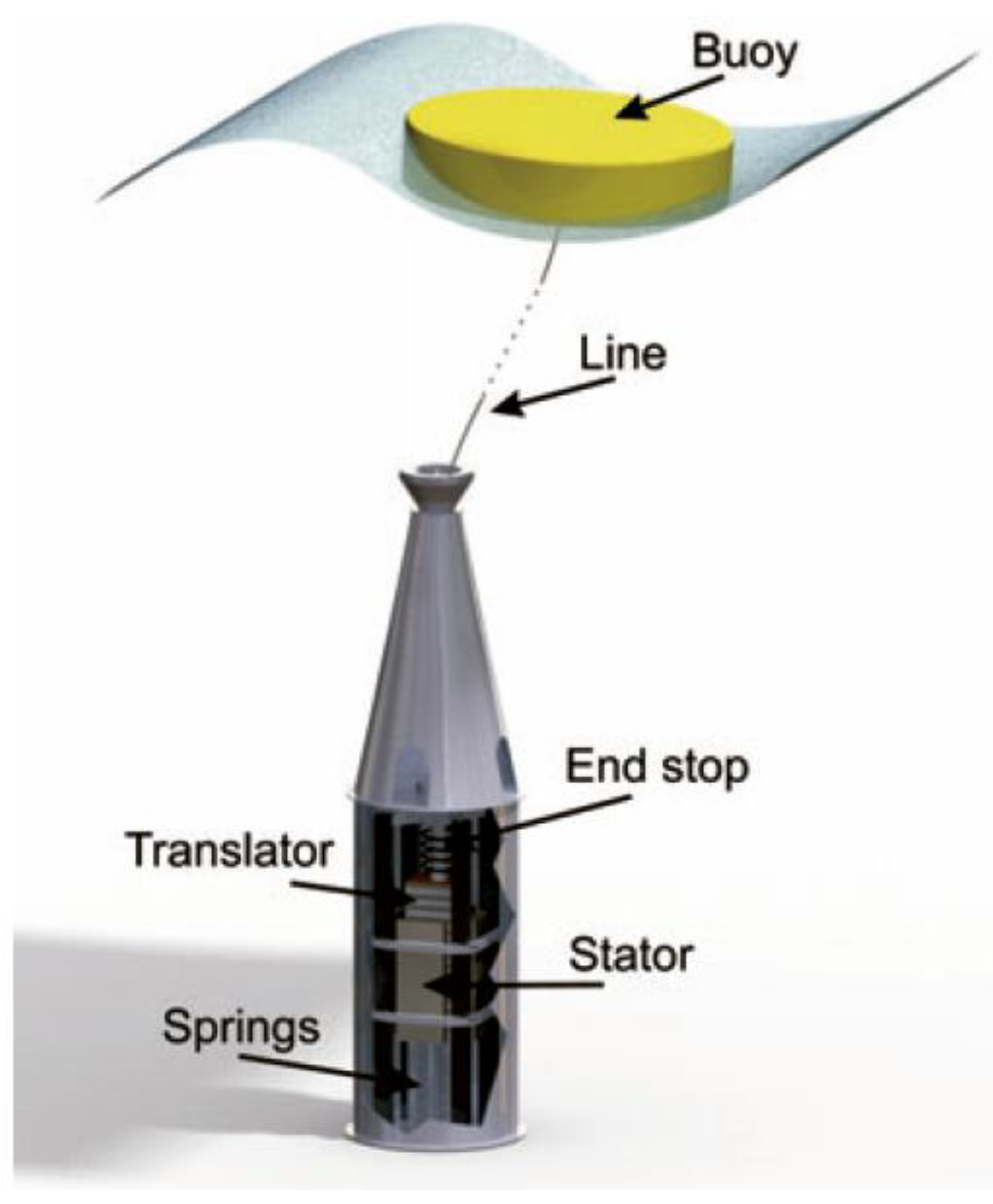
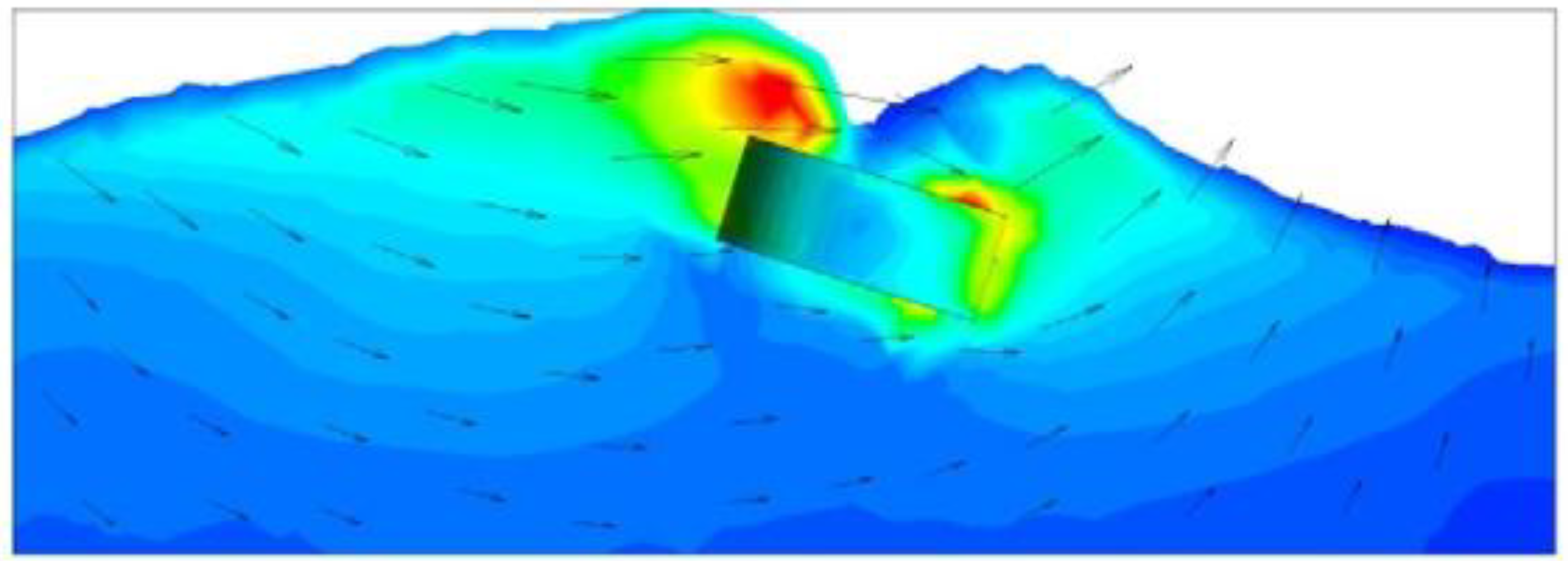
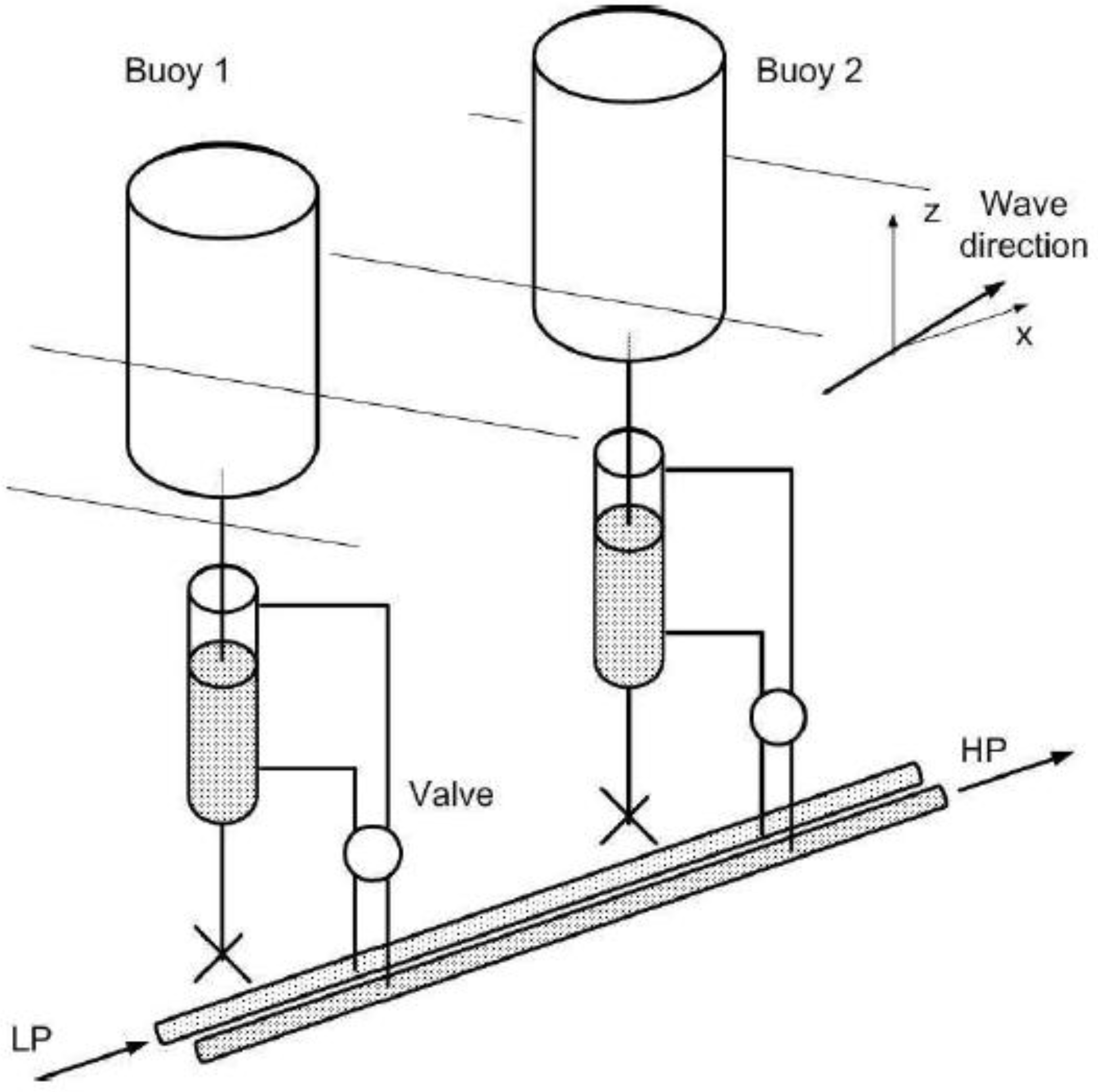
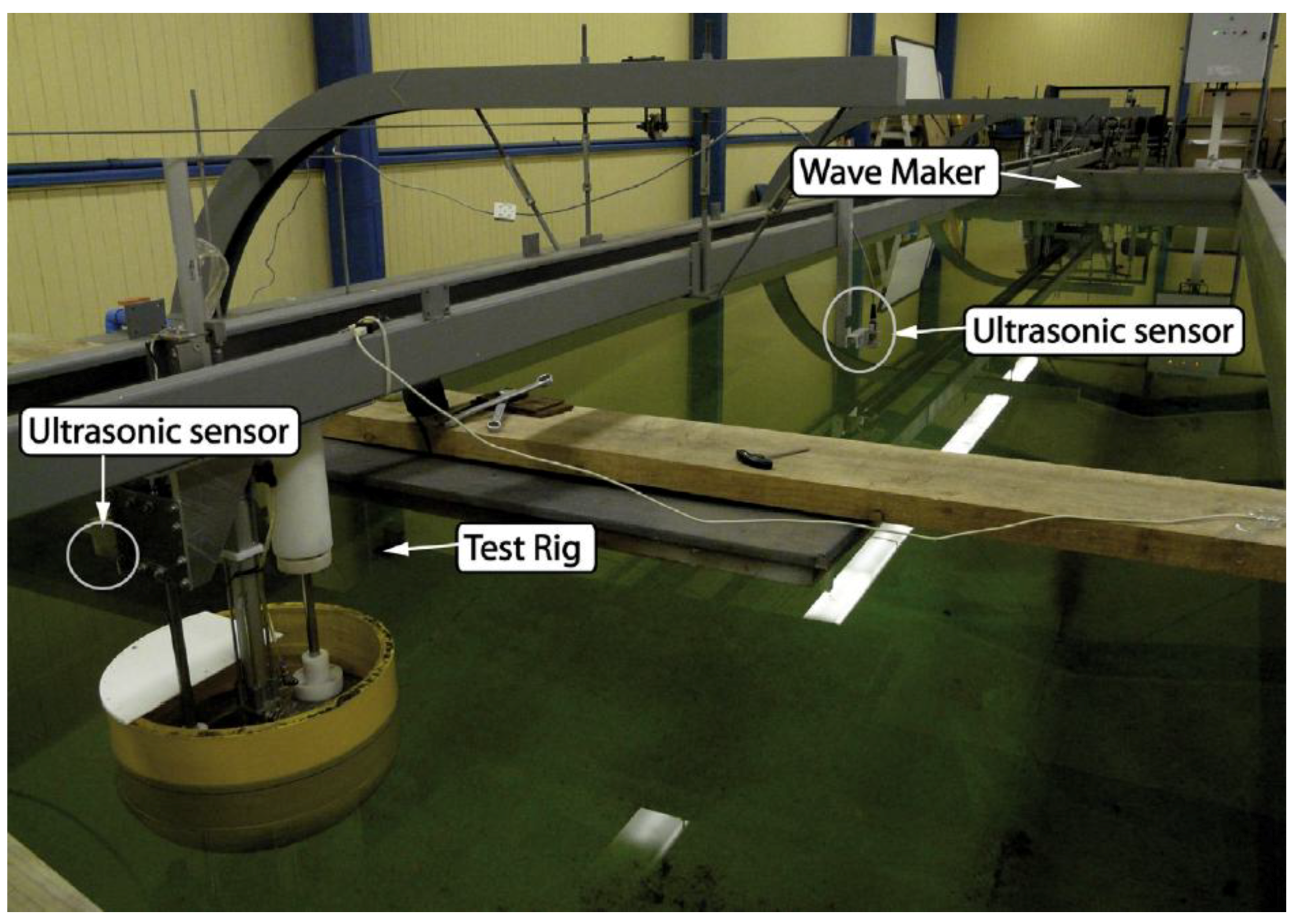
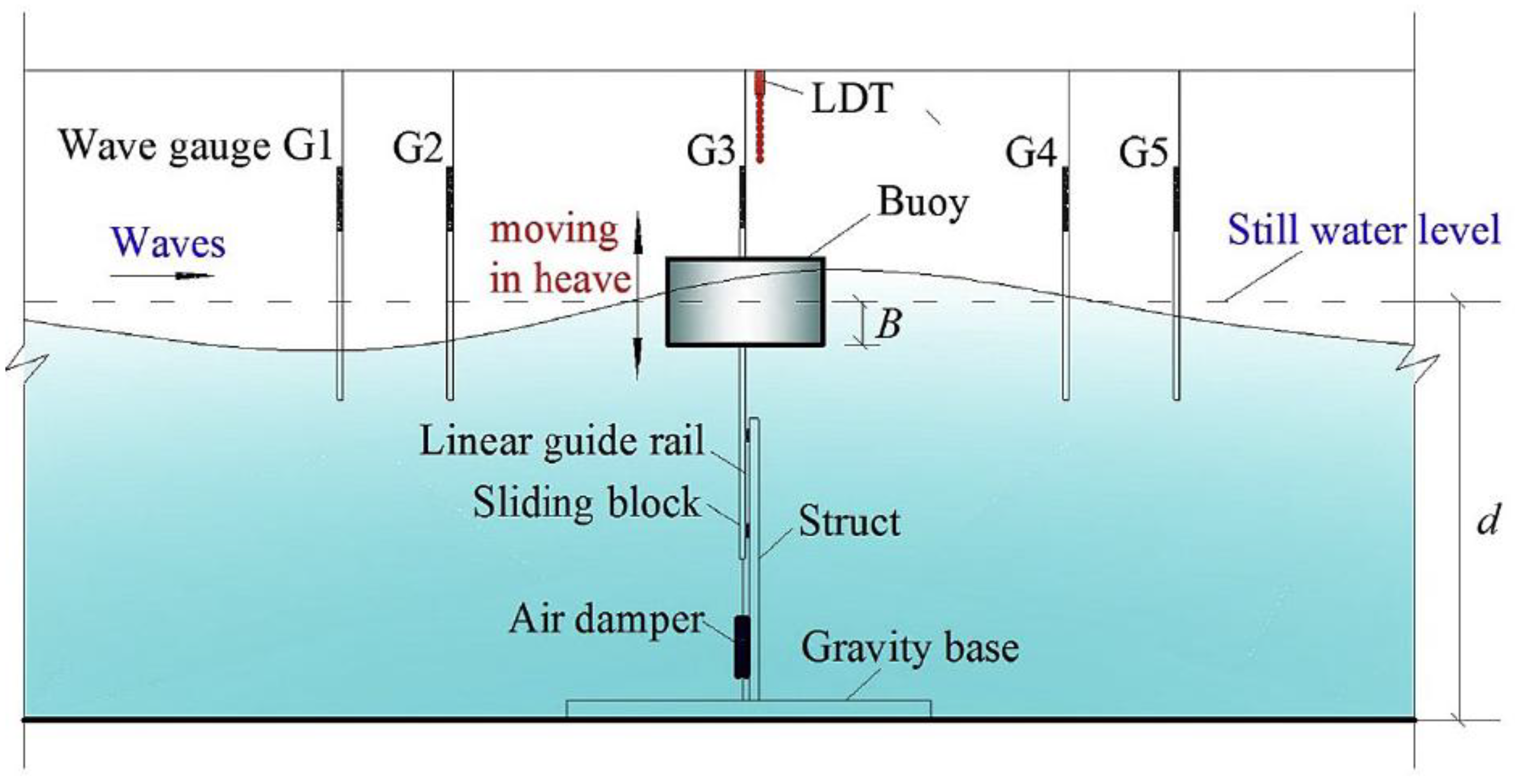
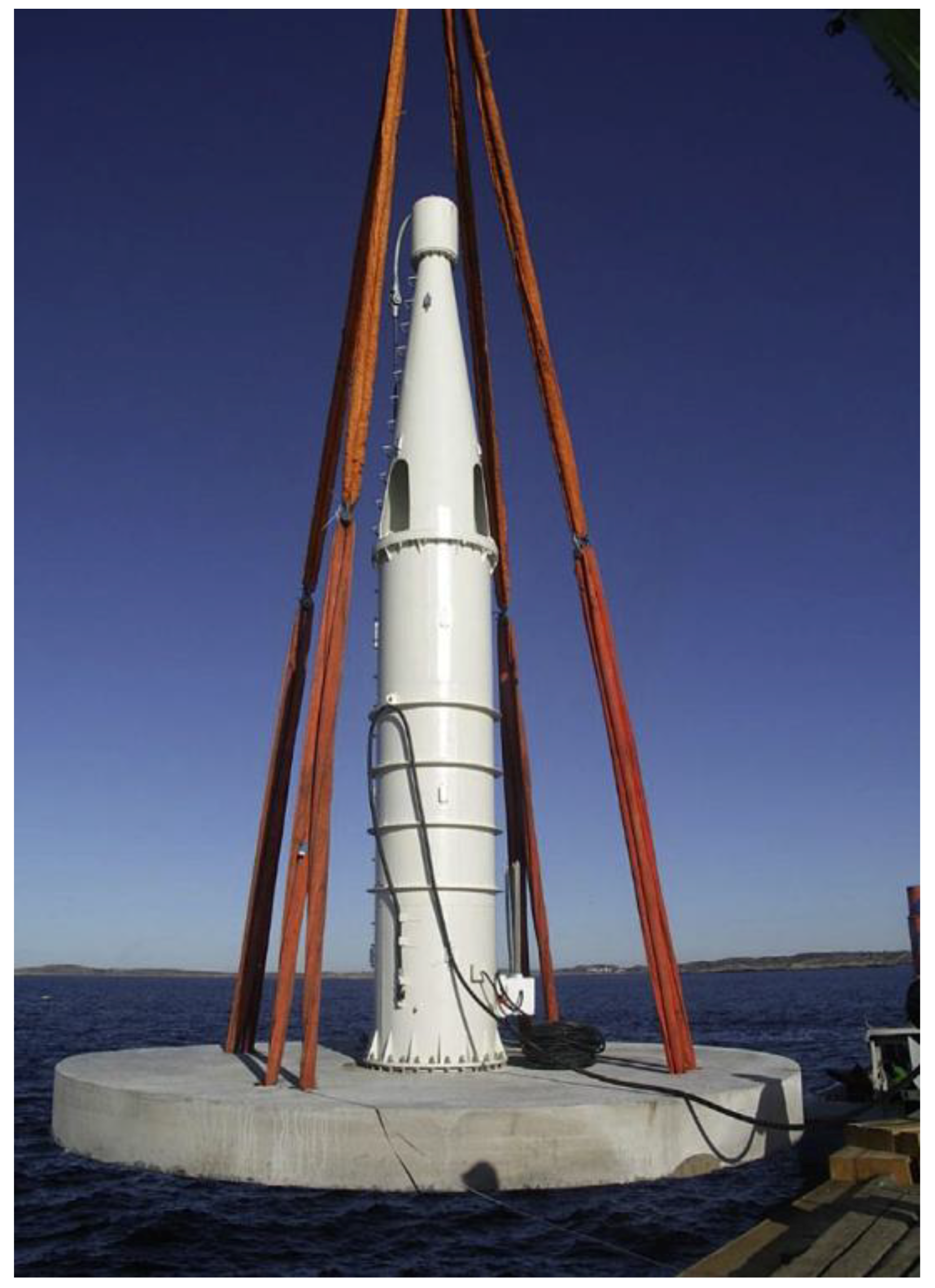
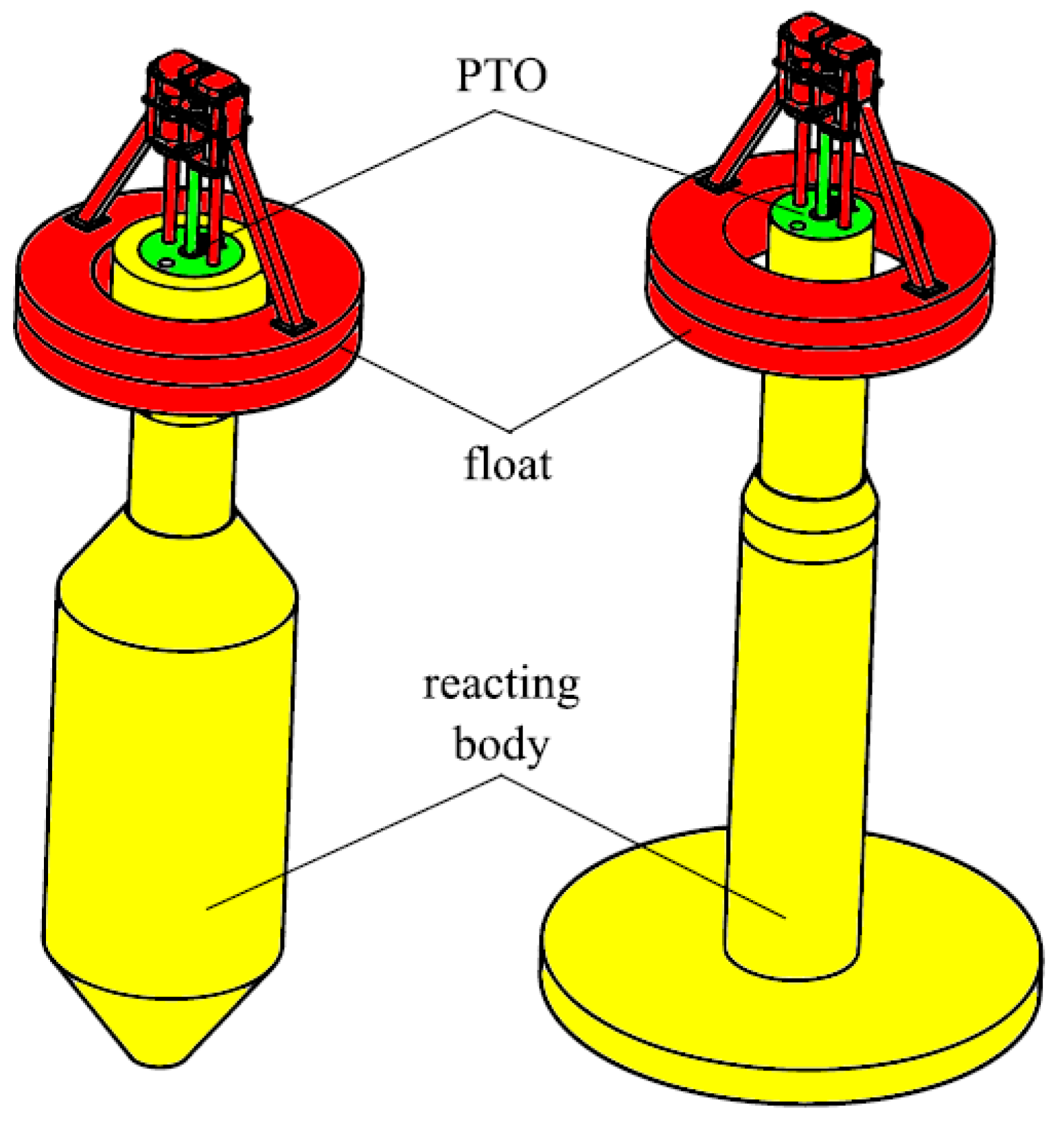
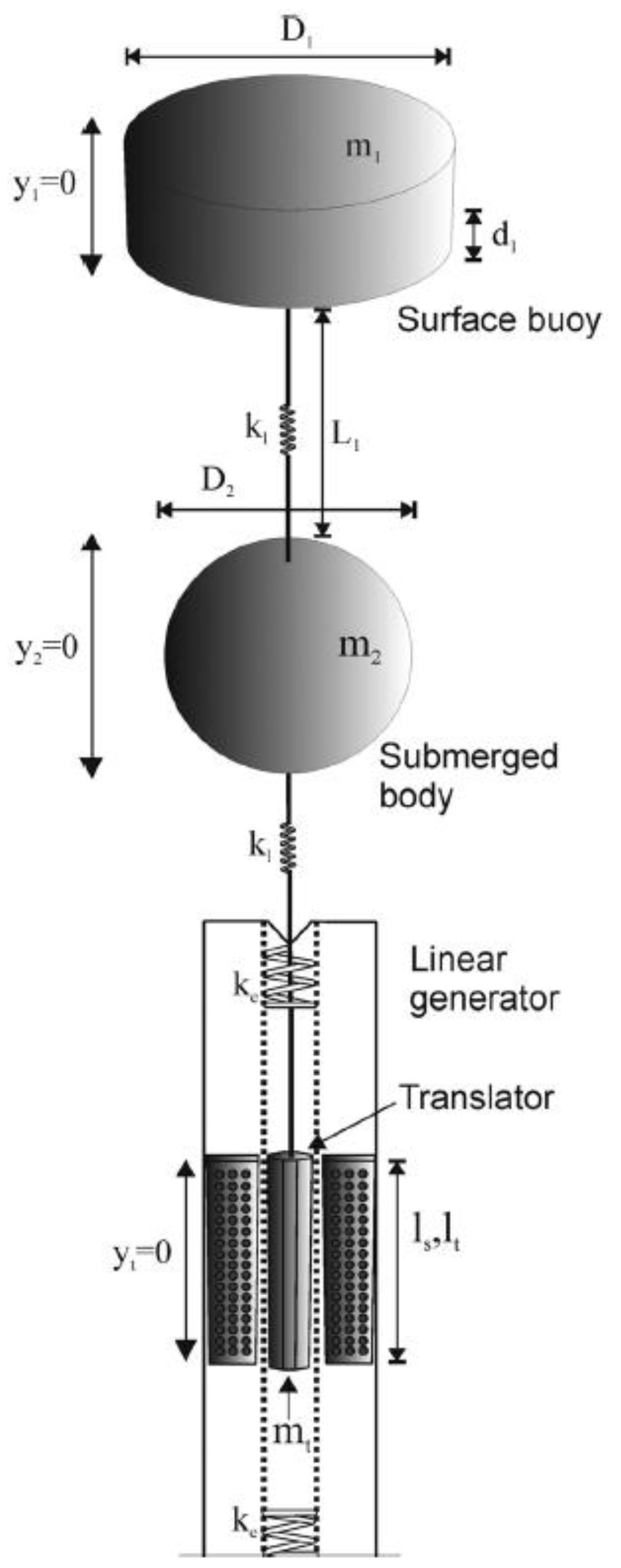
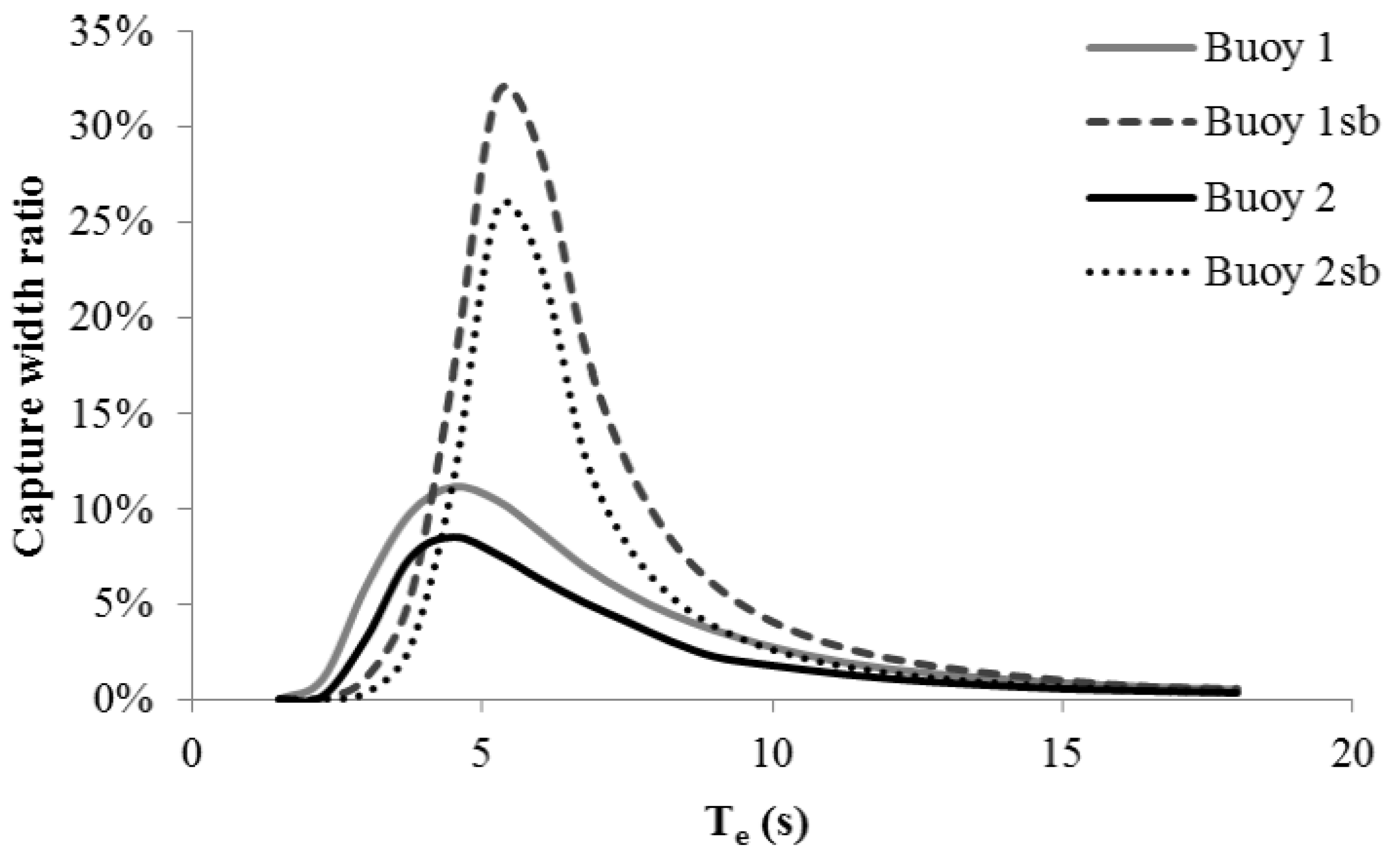
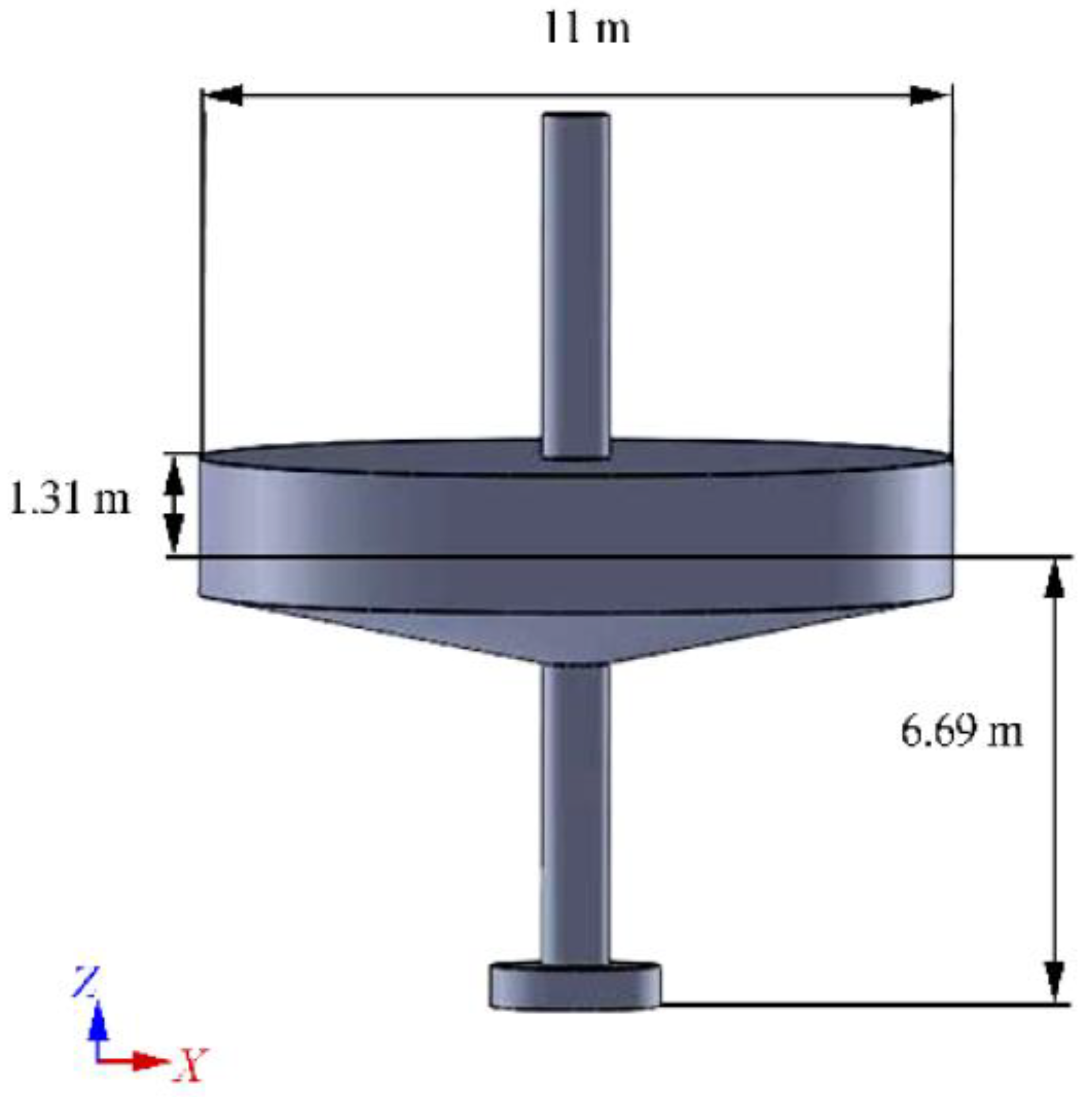
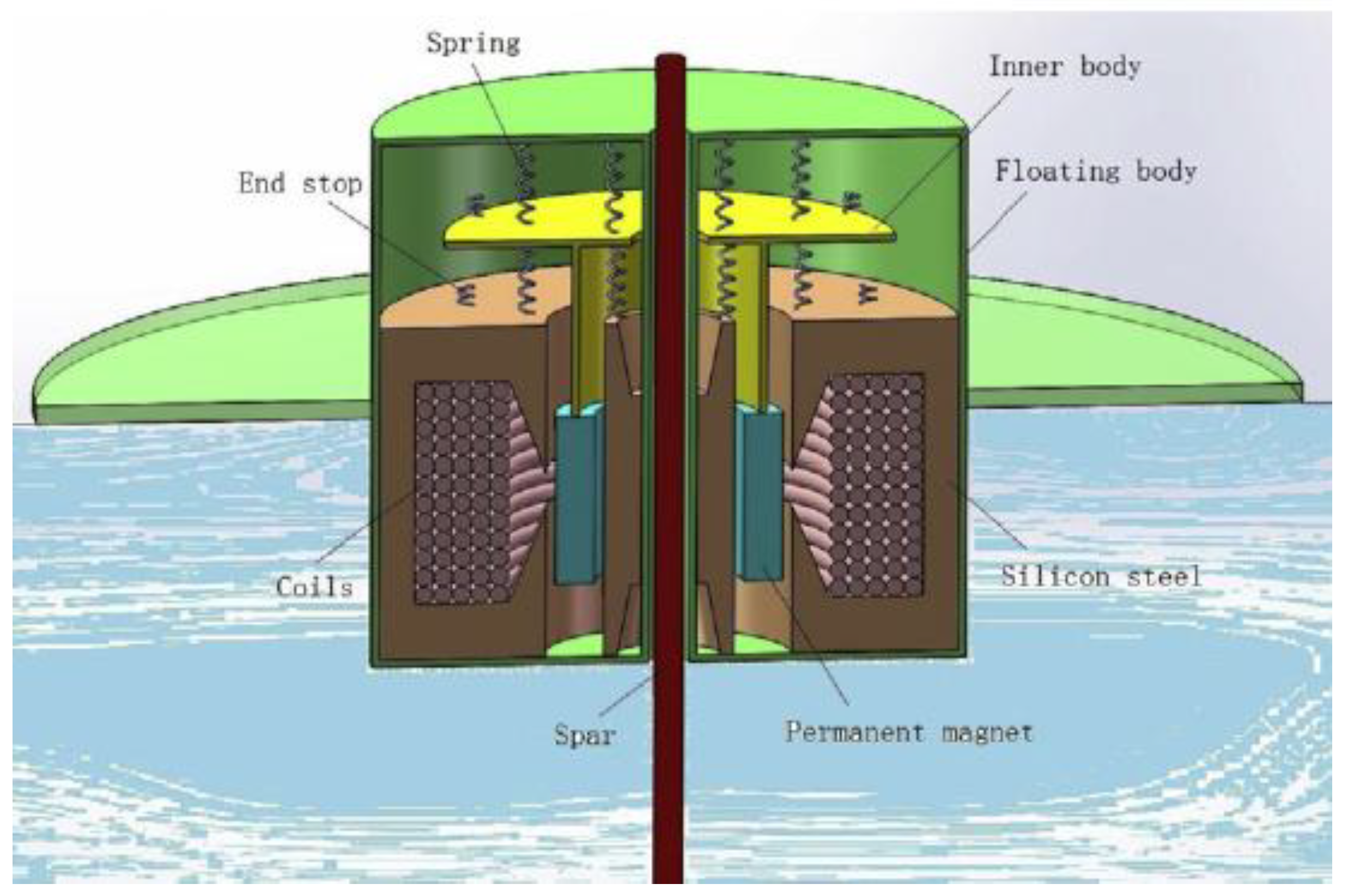
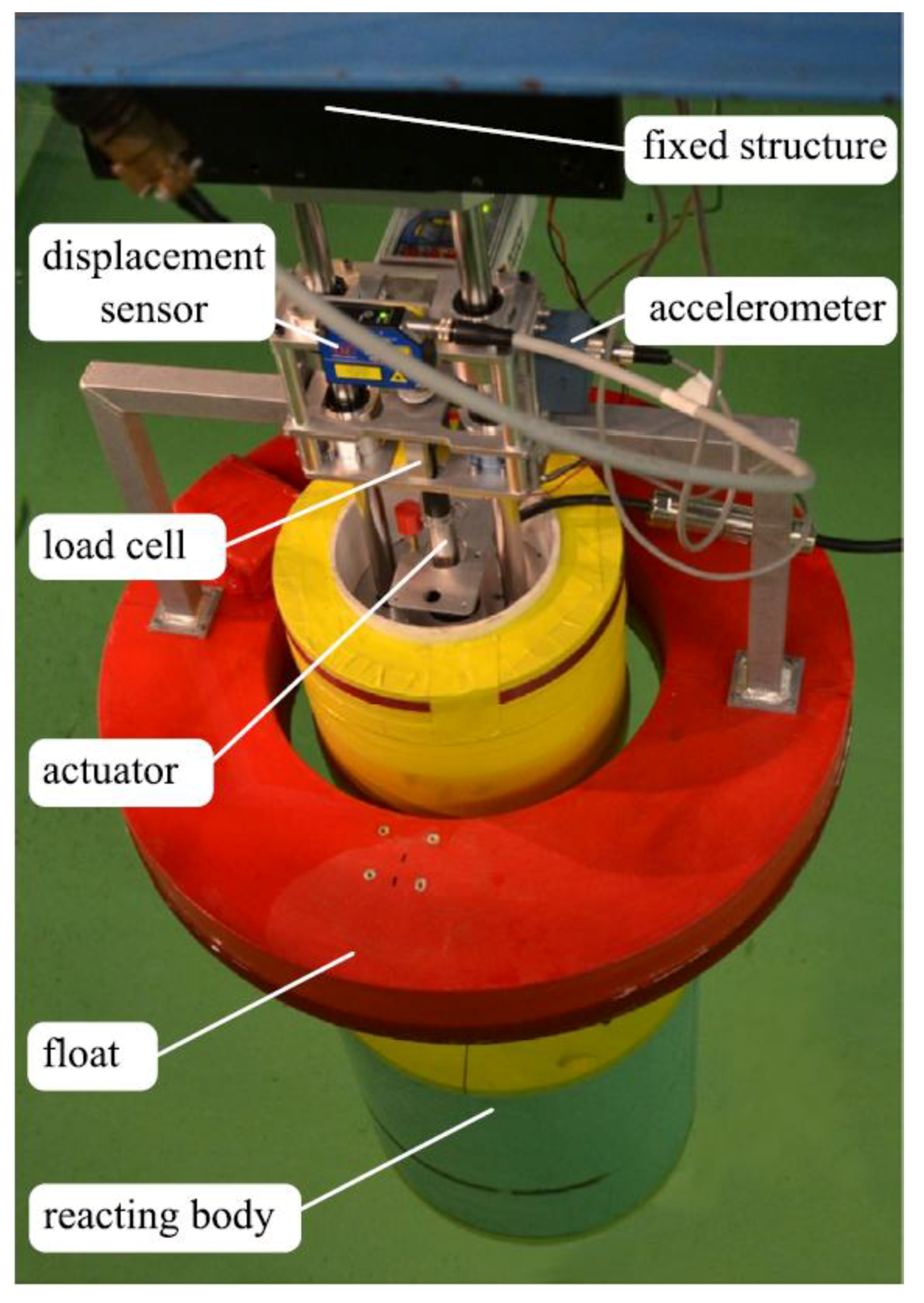
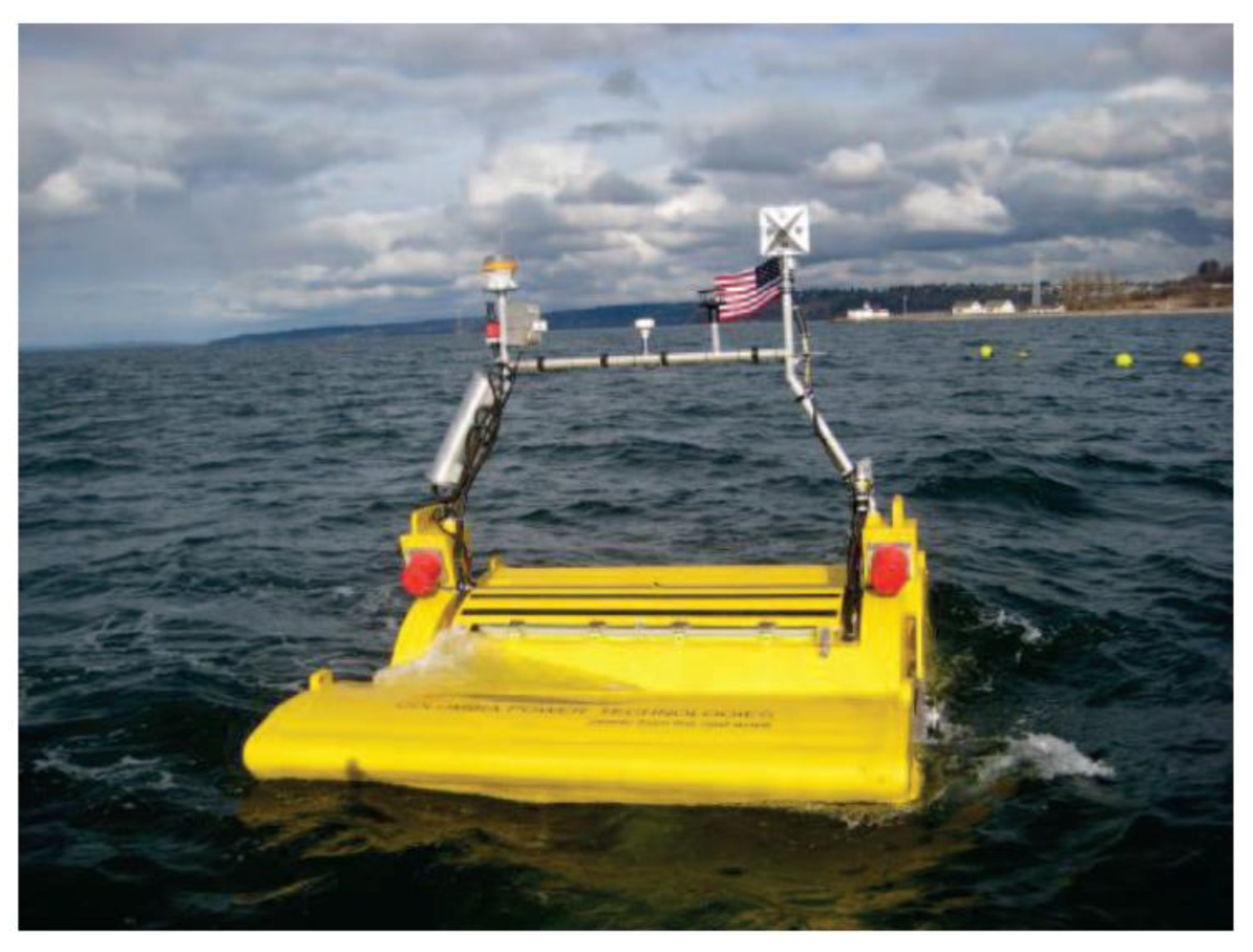
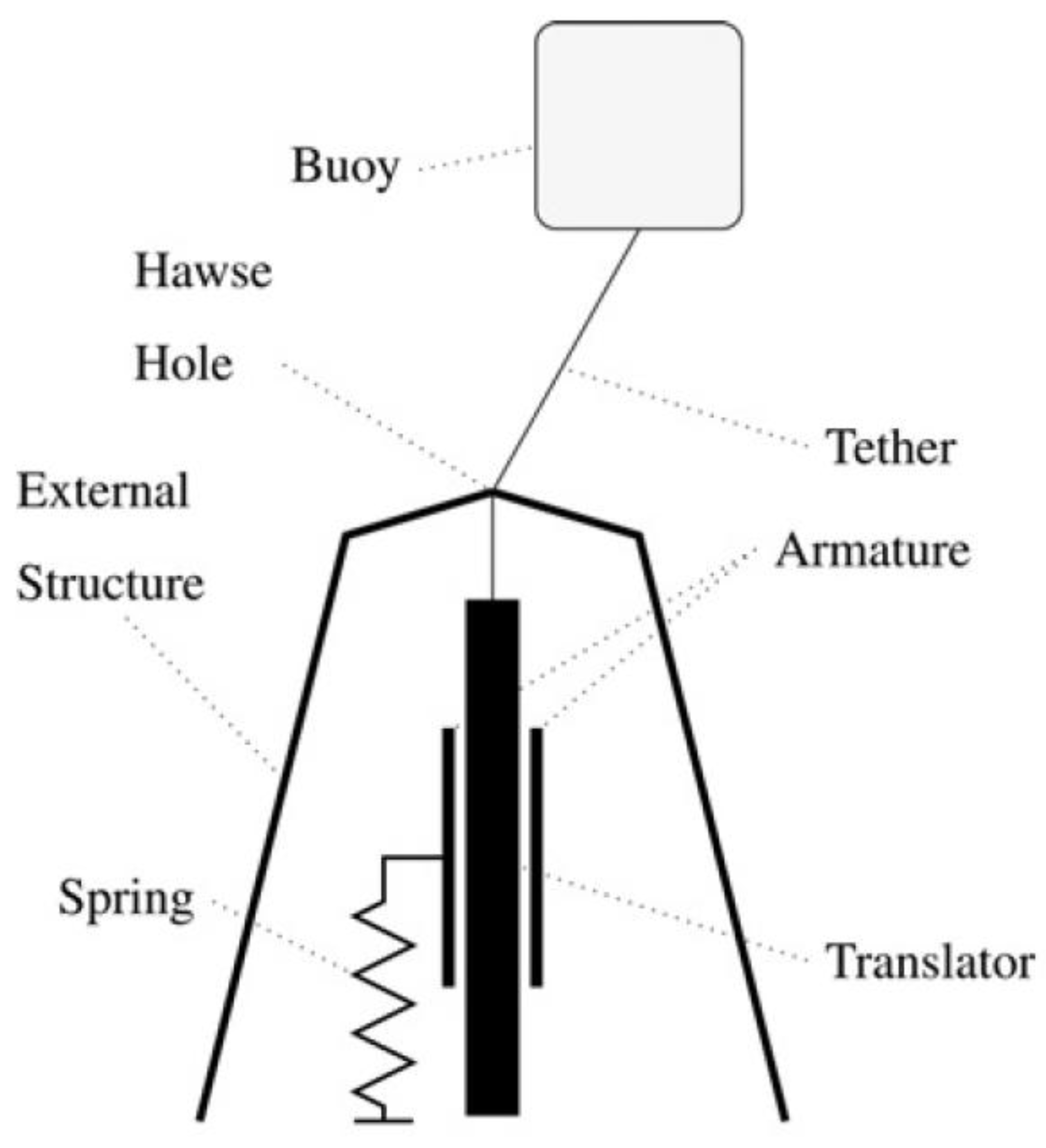
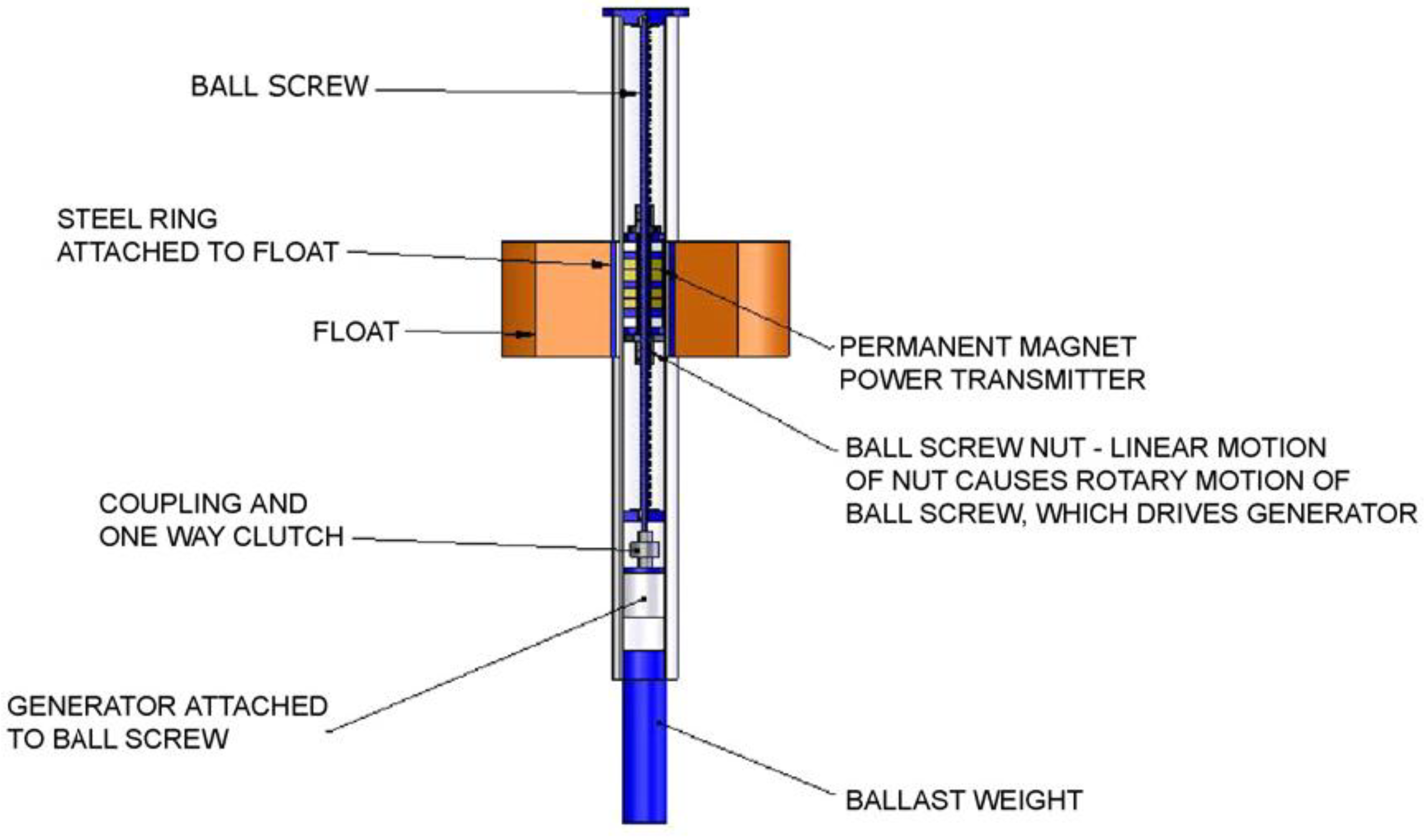
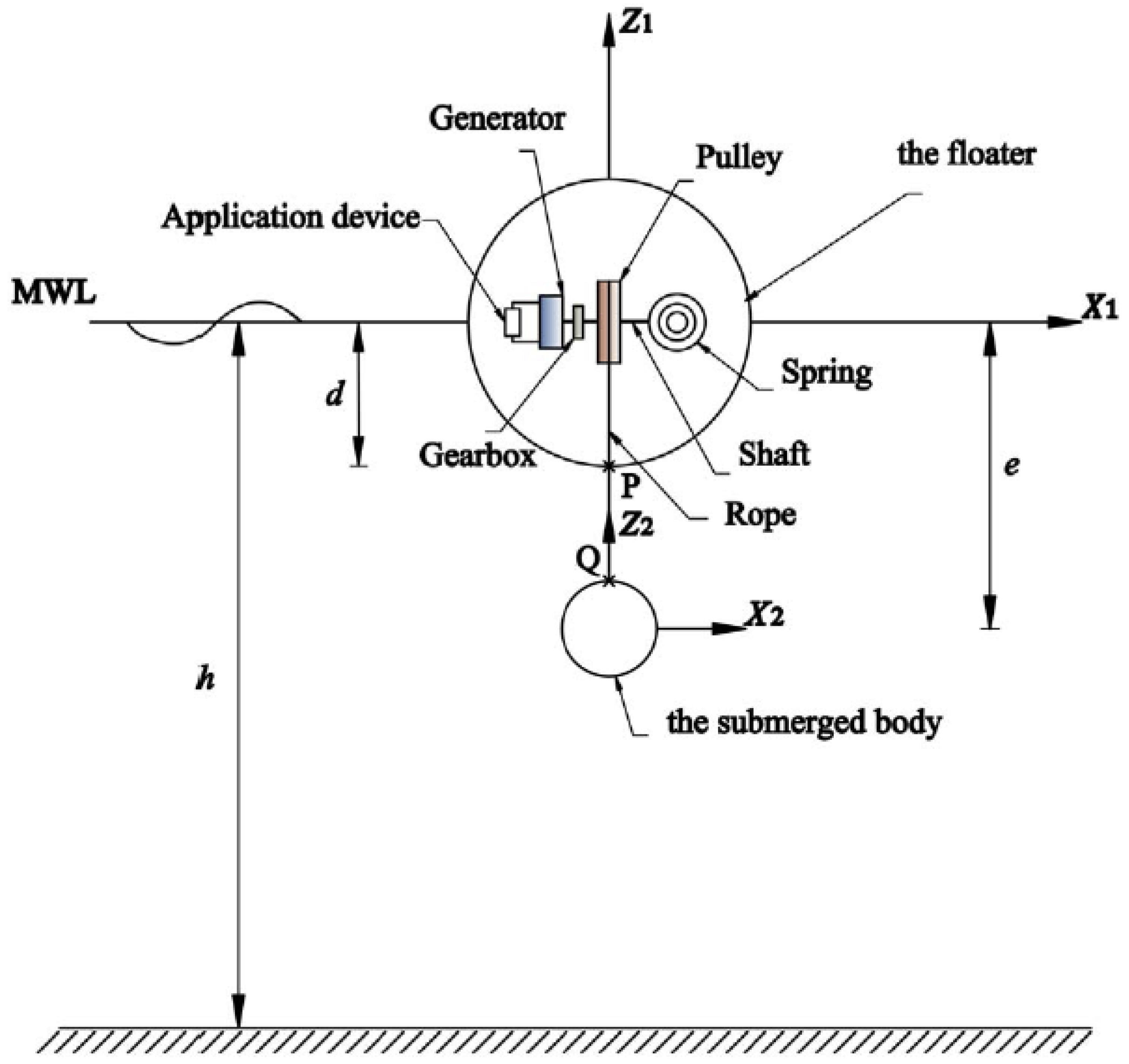
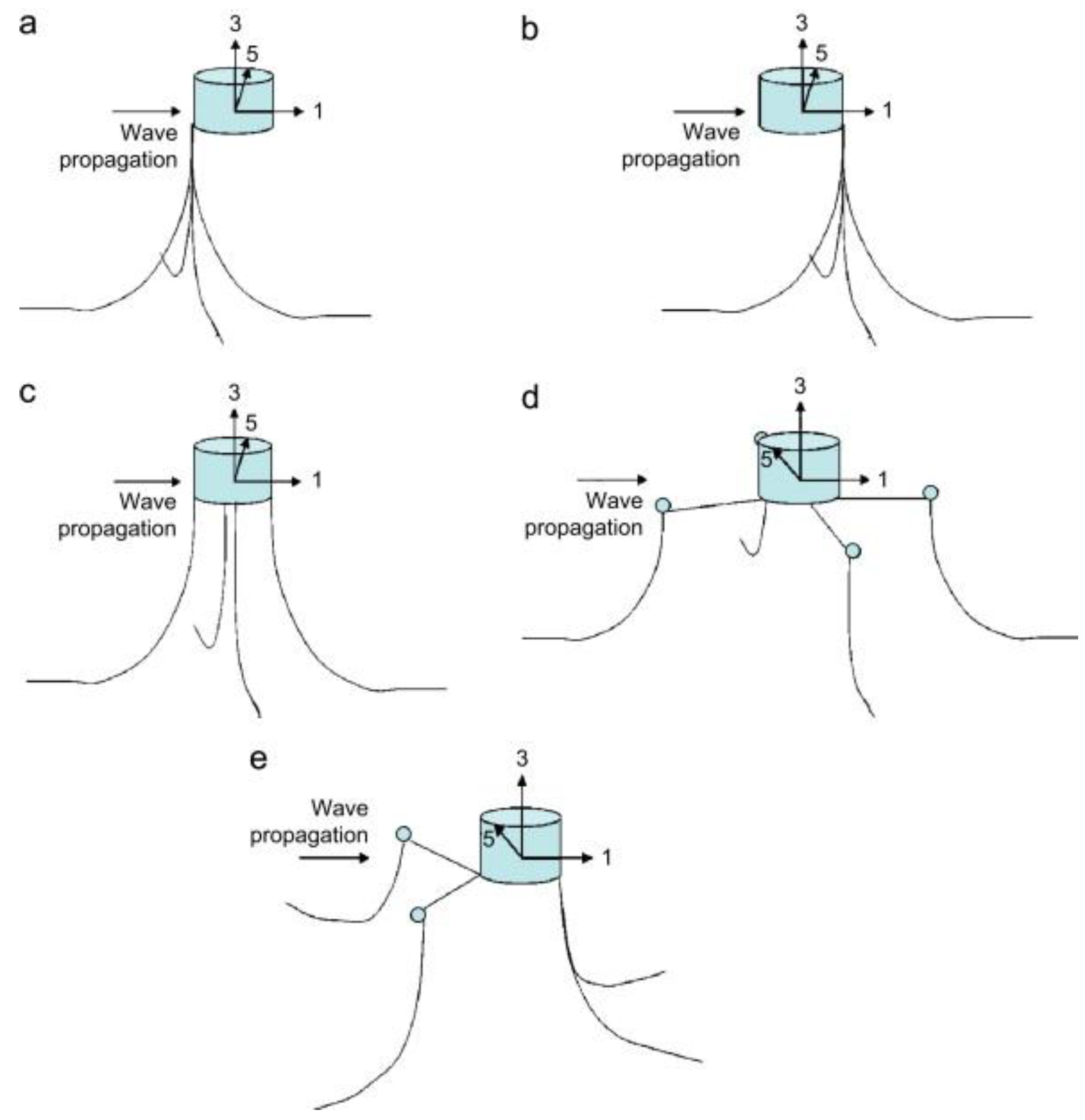
| Reference | Type | Innovation | Highest Efficiency | Tested/Scale | Target |
|---|---|---|---|---|---|
| Polinder, Damen and Gardner [36] | Linear generator | Transverse-flux permanent magnet | >90% | Yes/Full scale (sea testing) | AWS |
| Ulvgård, Sjökvist, Göteman and Leijon [44] | Linear generator | Forces variations analysis | N.A. | Yes/Full scale | Full scale point absorbers |
| Crozier, McKeever, Mueller, Spooner and Bailey [102] | Linear generator | Snapper spring system | N.A. | Yes/scaled to wave tank requirements | Full scale point absorbers |
| Sang, Karayaka, Yan and Zhang [37] | Linear to rotary | Crank slider mechanism | N.A. | No | Full scale point absorbers |
| Agamloh, Wallace and von Jouanne [105] | Linear to rotary | Contactless force transmission system/Ball screw nut mechanism | 60% | Yes/scaled to wave tank requirements | Full scale point absorbers |
| Liang, Ai and Zuo [7] | Linear to rotary | Rack and pinion motion rectifier | 28% capture width | Yes/scaled down and tested in the sea | Full scale point absorbers |
| De Koker, Degrieck, De Maeyer, Verbelen, Verbrugghe, Vantorre and Vandevelde [106] | Linear to rotary | Planetary gear system with control transmission | 88% | No | Suitable for small buoys |
| Boren, Lomonaco, Batten and Paasch [107] | Linear to rotary | Vertical axis pendulum | N.A. | Yes/scaled to wave tank requirements | Suitable for small to medium buoys |
| Takaramoto, Kashiwagi and Sakai [108] | Linear to rotary | Swinging mass like a pendulum | 34% | No | Suitable for small to medium buoys |
| Dai, Chen and Xie [109] | Linear to rotary | Pulley/spring connected to two submerged bodies | 20% | Yes/1:10 scale in a wave tank | Marine monitoring buoys |
| Hadano, Lee and Moon [110] | Linear to rotary | Closed loop with 4 pulleys | N.A. | Yes/scaled to wave tank requirements | Suitable for small to medium buoys |
| Kim, Wata, Zullah, Ahmed and Lee [46] | Linear to rotary | A working fluid inside the buoy operates a turbine | 35–45% hydraulic efficiency | Yes/1:3 scale in dry lab testing | Suitable for small to medium buoys |
| Ahmadian, Murray, Ghasemi-Nejhad and Rastegar [101] | Two stage linear | High frequency Piezoelectric | N.A. | No | Suitable for cylindrical buoys with large height to diameter ratio |
© 2018 by the authors. Licensee MDPI, Basel, Switzerland. This article is an open access article distributed under the terms and conditions of the Creative Commons Attribution (CC BY) license (http://creativecommons.org/licenses/by/4.0/).
Share and Cite
Al Shami, E.; Zhang, R.; Wang, X. Point Absorber Wave Energy Harvesters: A Review of Recent Developments. Energies 2019, 12, 47. https://doi.org/10.3390/en12010047
Al Shami E, Zhang R, Wang X. Point Absorber Wave Energy Harvesters: A Review of Recent Developments. Energies. 2019; 12(1):47. https://doi.org/10.3390/en12010047
Chicago/Turabian StyleAl Shami, Elie, Ran Zhang, and Xu Wang. 2019. "Point Absorber Wave Energy Harvesters: A Review of Recent Developments" Energies 12, no. 1: 47. https://doi.org/10.3390/en12010047
APA StyleAl Shami, E., Zhang, R., & Wang, X. (2019). Point Absorber Wave Energy Harvesters: A Review of Recent Developments. Energies, 12(1), 47. https://doi.org/10.3390/en12010047





